VIDEO+RADIO+LIVE
Livestream of Live Performances,
Casa Artelor, October 2nd, 6-7:30pm
Catinca Malaimare
Live performance broadcast, between movement and rest, duration 1h, daily 6-7pm Casa Artelor, Timișoara
Sanja Latinović
“On Time”
Live Performance broadcast live from Belgrade
Performance Videos
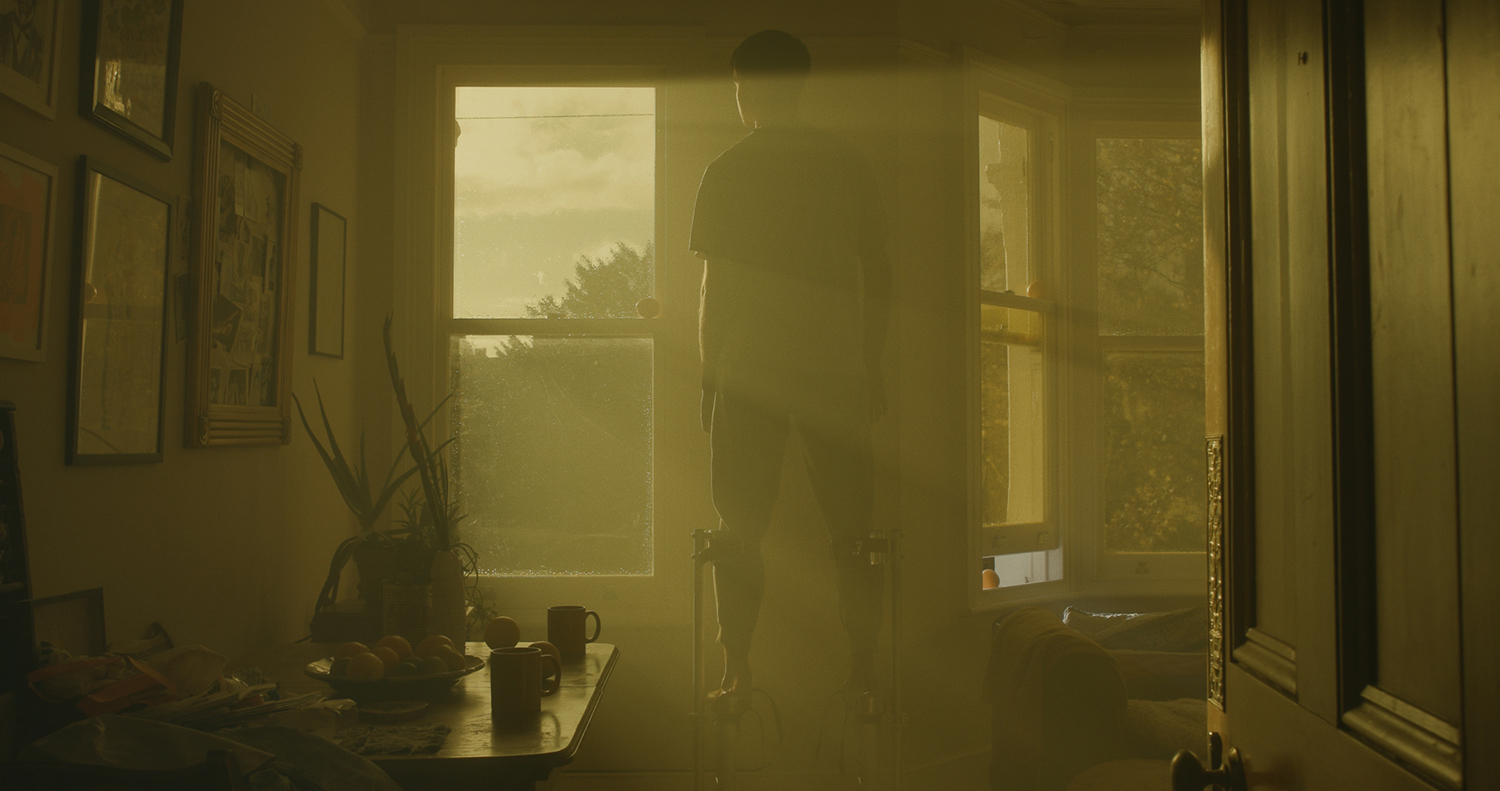
Mădălina Zaharia & Ryan Ormonde
Public Figure
2K film with sound, 9 minutes and 43 seconds, 2021
Public Figure is a lyrical account of a body in space, a metrical composition in which poet Ryan Ormonde is carefully observed and re-imagined by Zaharia’s cinematic eye. Through this exchange, the poet and the onlooker are collectively staging a particular sense of ‘publicness’, a certain type of relationship that relies heavily on the tension between the body and the voice, and has its source in practices of embodied poetry and writing. The film is guided by the changing and wavering voice of the poet, a voice completely independent from the body and at the same time in restless search for a physical host, following its presence around the fictitious and dreamlike set of a domestic interior.
Director & Producer: Mădălina Zaharia
Writer & Performer: Ryan Ormonde
Director of Photography: Emma Dalesman
Music & Sound Design: Joshua Fay
Voice: Ryan Ormonde
Choreography: Daniel Hay-Gordon
Costumes and Set Design: Thom Shaw
Focus Puller: Christopher J. Orr
Gaffer: Sabrina Corda
Colourist: Jason R Moffat
Voice-over recording: Chris Smith (Kluster Sounds, London)
Catinca Malaimare
Clip from live performance between movement and rest, Medium Bastard Amber, (2021), duration 1h, daily 6-7pm Casa Artelor, Timișoara
Medium Bastard Amber is a birth name that stands for average intensity, hybrid origins and the coloration present in an LED light filter for the enhancement of the skin’s undertones, with consistent color results from batch to batch. It serves as an analogue device that carries out the loud voice of a rhetoric of sentient flesh, a technological bastard with a huge amount of human form around it.
Medium Bastard Amber will be performed for 360 mins in good visibility, for the public eye, inside the Arch of Casa Artelor, while the remaining ### mins will be performed before the tense sightlines of private encounters, in-between blinks.
Our tandems turn into tripartite bodies, chaotic, makeshift anatomies turn their anthropomorphised features into creatures we empathise with in our shared imagined spaces. Motorised, automated bodies facilitate our attempt to rationalise those technological bodies we increasingly don’t understand, a feeling intensified with each episode of intimacy we tender to.
Camera: Rocio Chacon
Choreography: Mariana Gavriciuc
Mechanics and automation: Mihai Drăgan
Performance Videography: Răzvan Riscută.
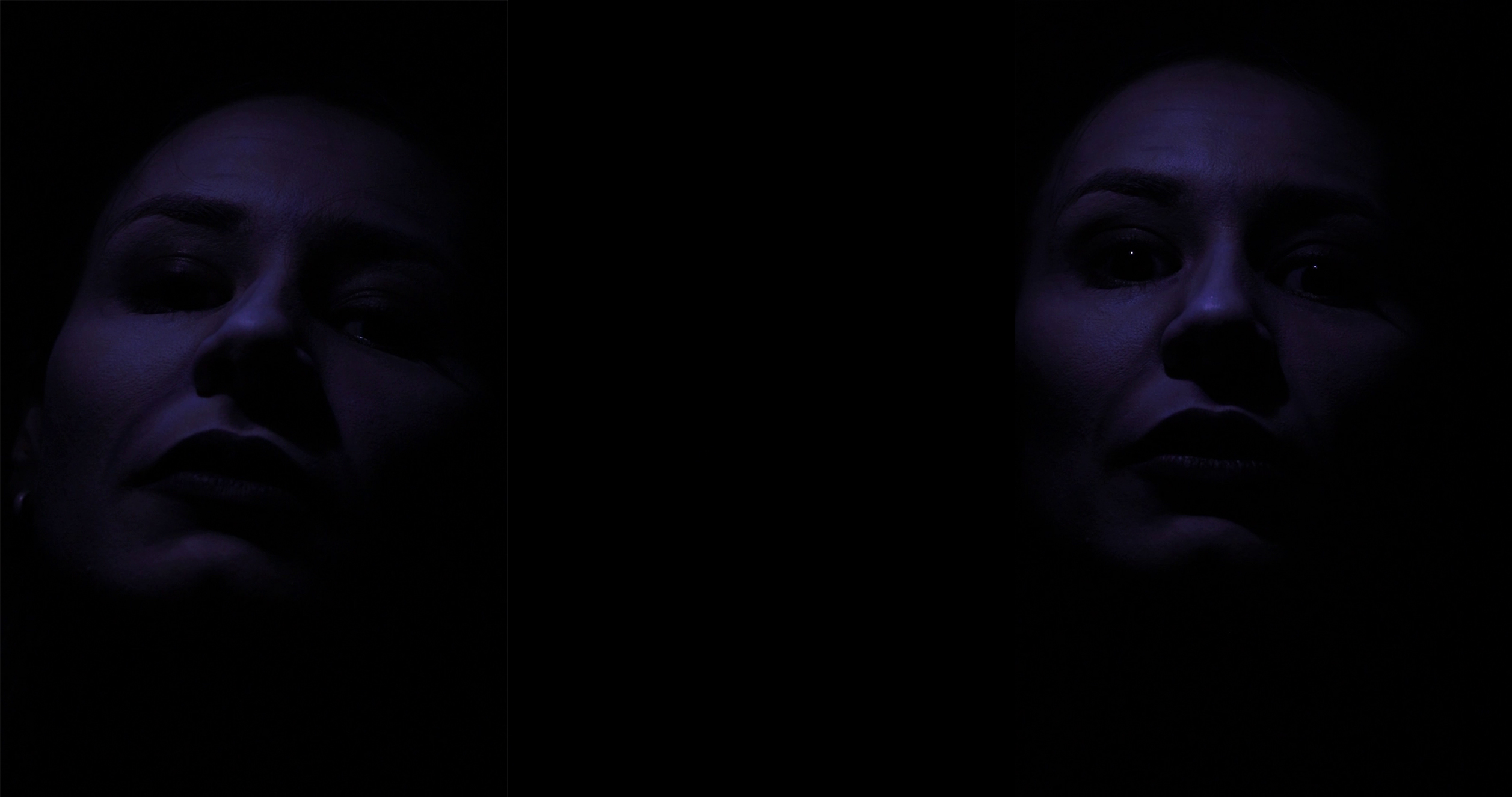
Silvia Amancei & Bogdan Armanu
GAME OVER
HDV, 6:30 min, single channel with sound, 2021
The screen deceives the eye making it void of space while the camera imposes its own ideological agenda. The game can only be played by the imposed parameters, no deviation from its mapping being permitted. The realities of the cinematic narrations, either interactive as video games are, or not, are prescribed while the freedom of interpretation and interaction are very much limited.
Taking advantage of our presence in the exhibition VIDEO+RADIO+LIVE, extension of the Art Encounters Biennial, we propose to interrogate our personal and professional relationship with this representative event for the scene, simultaneously searching for the definition of the interpersonal relationships that substitutes the presence of an institutionalized network in Romania (financed, autonomous and without political color).
GAME OVER is a video-performance on one channel with 2 monologues (Silvia Amancei and Bogdan Armanu) that searches to deconstruct, through a subjective view, the mechanics of the art world. Shaping a critical and introspective stand upon the process of artistic production and its performativity, a video installation that proposes to underline the fragility and uncertainty from behind the art charade.

Arantxa Etcheverria
RED DOOR BLUE DOOR
Wood, acrylic, 190 × 152 × 80 cm & video, colour, 10:30 min, 2021. Model: Ada Musat
Red Door and Blue Door are performance works that belong to an exhibition project titled Apocalypse/Beatus, a series of photo-montages inspired by XIX century Spanish beatuses. “Beatus” is an Iberian manuscript from the Middle Ages where the interpretations of the Apocalypse after Saint John were commented on and deciphered. The Apocalypse is a term that heralds the end of these worlds, but at the same time a new beginning, a supreme happiness.
Red Door and Blue Door talk about interpreting these terms in a performative manner, through a guard sitting in front of a door, in a meditative posture. The architectural constructions on which the guards are seated are inspired by two exterior areas of the building where Arantxa Etcheverria has her artist studio, a modernist house built by Marcel Iancu in 1934. The recomposed architectural pieces allow a moment of thought, a pause, a reflection on the lived moment, despite the external movements.”
(Text by Eugen Rădescu, English translation by Cristina Bută)
RACHEL MONOSOV
LIMINAL
3-channel performance-video, sound, 42 min, 2021
Inside this Liminal phase, we can change our identities and our governments. We exist in between the life we lived before and the life we will live after… whenever after comes. Still, the lasting effects on our psyche and social behaviors are still unknown. The only thing we know is that we miss touching another body, we miss our own bodies which could rebel! We are looking for the place of healing through movement together.
The boundaries between us have dissolved. The lens replaces your eye, initiating and sustainging contact. ENTER liminal.contact
Liminal is a performance-based video work which translates the diverse states of our psychic and physical being during the Covid-19 pandemic into a digital exhibition. Conceived in early 2021 as a website to allow the public to virtually enter the three rooms of Villa Massimo in Rome without restrictions, this October, at Casa Artelor in Timișoara, the work is presented for the first time as a 3-channel installation available for in-person public viewing.
Concept and Choreography: Rachel Monosov
Co-Choreography and performers: Rachell Bo Clark, Stephanie Amurao
Music: Philipp Rhensius
Composer: Santa Bušs
Singer: Julia Shelkovskaia
Camera: Andrea Arnone
Video Editor: Vera Rosa Maria Herr
LIMINAL was originally commissioned by Accademia Tedesca Roma Villa Massimo.
Daniela Palimariu
Vineyard Slips
Excerpt from 4 channel video installation, 4K, 9’47”, 2021
To err is human; to forgive, divine.*
A group of well-intended friends, partners and acquaintances have dinner in an idyllic spot, deep between two vineyards. They do their best to capture, to profoundly feel the beauty of it all; the smells, the colors on the table and around, the good company, the lively conversations. They enjoy each other’s company and are committed to not letting anything ruin the relaxed vibes, although slips and mistakes of all kinds follow the group throughout the evening. Scripted dialogues trickle in amongst natural conversations, creating strange, awkward moments which are just as easily overcome by the overflowing joy of the guests. Coming from various contexts, and of different age groups, locals and international visitors, they almost instantly form a community whose sole purpose is creating well-being.
The backdrop of the event is a seductive one, however the attention of the participants is focused solely on the dinner itself, on its ingredients. The group is particularly present and forms a specific noise – it attracts us into discussions that, although sometimes unpleasant, are inevitably surrounded by roars of laughter. Distributed on the four channels, the large views, the details, the dialogues, all in continuous motion and variation, use euphoria to make us dizzy.
Like many of Palimariu’s works, Vineyard Slips deals with the challenges of informal group gatherings, here combining scripted action with organic social dynamics, bringing together moments of familiarity and plain strangeness. Using contrast, seductive scenography, out-of-context dialogue, and a carefully curated meal design, the work embraces both the human fragility and its frivolity.
*Alexander Pope, 1711
Navid Nuur and Adrian Ghenie
The Possibility of Purple
Mixed media, video 46 min, amplifier, studio materials, 2013
[…] The two artistic discourses achieve new potentialities in this encounter, through the direct access they offer one another to work, to the physical and affective correlates of artmaking. A video work shows Navid Nuur holding a microphone connected to a Marshall amplifier, voicing out Ghenie’s act of painting as it unfolds in front of him.
A first iteration of this project was exhibited at the first edition of Art Basel in Hong Kong in May 2013 and was awarded the Discoveries Prize. Guggenheim Museum’s curator Alexandra Munroe describes the project: “The installation by Navid Nuur and Adrian Ghenie encompasses performance, sound, painting, and assemblage in a complete environment that has keen art historical and critical relevance. It wrestles with the history of modern painting while showing an exciting and fresh perspective. Working collaboratively, the artists go beyond the constraints of conceptualism and engage with more current languages of art.”
Sanja Latinović
“On Time”
Live Performance broadcast live from Belgrade
The artist shoulders a yoke weighted with water to offer nourishment to young oaks on three successive evenings, the time of day when water is most easily absorbed, ensuring the basic metabolic processes necessary for their survival. Nevertheless, the trees are in poor condition.
The plight of the trees can be seen as literal or associative. As living entities, they are locked into an interdependent cycle with their environment which necessitates a struggle for equilibrium. Taken as an approximation they can represent individuals in a wider society who require nourishment and support from their own cyclic environment. More broadly, the situation raises questions regarding our own attitudes, actions, and place in a world facing major existential changes.
How honest are our intentions? Is the watering of dying trees an act merely to assuage our own guilt, an ironic attempt at palliative care, or a consequence of the desperation and anxiety created by a lifetime of neglect? Or is it possible that our actions bud and bloom from love, compassion, mutual wellbeing and hope? Perhaps there is a beam of light on the path ahead.
Latinović’s practice is stark and direct. There is no relentless tide of clichés (turning point, elitist hierarchy of the art world, hotbed of radicalism, alienated modern lives) nor walking through labyrinths of meta and micronarratives. Her work seeks to trigger ruminations about duty, needs and negligence. By performing she reflects on the most potent moment to intervene, acknowledge and esteem what is around and within us.
- Jelena Veljković Wilson
Due to the travel restrictions imposed to ameliorate the effects of the pandemic, Sanja Latinović’s live performance initially programmed to takes place in the atrium of Casa Artelor in Timisoara will be instead be broadcast live from ___ in Belgrad each day at 18:00 Bucharest time.
Alexandru Antik Sándor
Memories implanted in the landscape of everyday life
Film, colour, black & white, 2021
My old actions have remained in my memory like ghosts, which reappear today in the most unexpected situations. They often appear only as fragments, without the background of old artistic actions, and deprived of their symbolic role. I wondered what it would be like to invoke some of these memories of my actions, how I could implant these in the current landscape of my daily life. These actions – whose real or imaginary spaces I chose then in accordance with my symbolic message – have now lost their performative character or their happening characteristics. They are rather metaphorical walks in the footsteps of memory, with the aim of reviving our increasingly blurred memories, a possibility to perceive them implanted in the setting of our daily lives. A meditation through rituals performed to make up for lost time. Thus, a mixture is made between the imprints of our old actions and the intuition of future actions.
In this new set-up, Alexandru Antik starts from some of his real artistic actions, older or newer, and presents them in a film. These actions – which were initially interpreted by the author in real places or in imagined spaces, thus lose their character of real happening-event, or of actions in which a performance takes place; rather, they appear in the film as minimalist events, as uses of film recordings, in a form of inter-relationship with their dubbed variants. In this way, they appeal to the individual or collective memory, awakening our memories, dreams and experiences from the past, which lie in our subconscious.
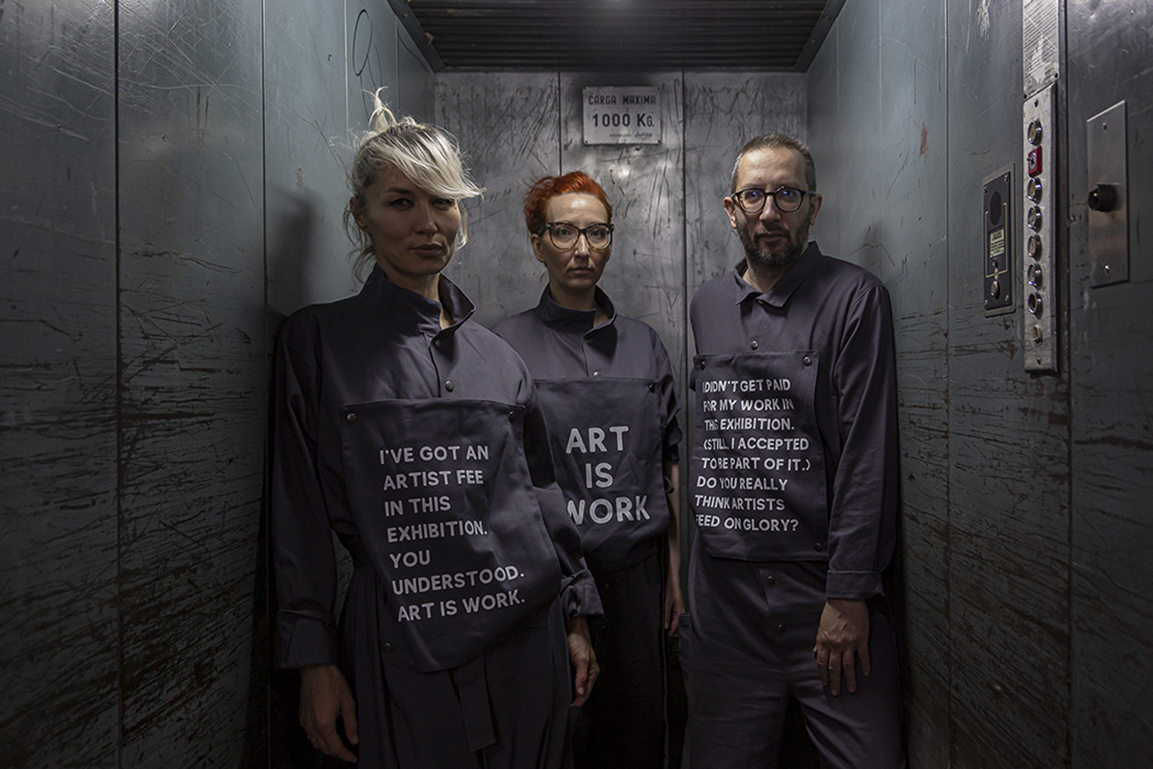
Apparatus 22
ART IS WORK – Voices of a Community
Durational live performance daily during Opening Weekend Exhibition hours
+ installation (2 x ART IS WORK uniforms: artist version & curator version, video statements)
+ instructions for exchange (Timișoara: 11 uniforms), 2011- ongoing.
Through the texts inscribed on the two “ART IS WORK” uniforms for artists and curators opens crucial conversations about the recognition of artistic and curatorial work and continues a long-term commitment of the art collective to set in motion processes of change. “ART IS WORK” has Tuta as a starting point – an overall, ambitious piece of clothing, designed a century ago by Italian designer and artist Thayaht, well known for his involvement in the Italian Futurist movement.
Apparatus 22 offers a new use and a new mission for Tuta: the jumpsuit becomes a tool for calling into discussion the working dynamics from the art sphere in contemporary society, oftentimes defined by a precariousness that escapes sight, by exploitation and self-exploitation.
The recognition and monetary pay for the work of artists and curators—or, more often, the lack of this recognition and its quantification—becomes the central theme in two sets of statement-uniforms to be used at openings, the most celebratory moment for artistic/curatorial work.
“ART IS WORK – Voices of a Community’‘ is distributing 200 empowering uniforms for artists and curators from several international scenes between June and December 2021. Therefore, also in Video+Radio+Live in Timișoara, the Apparatus 22 uniforms and their activist ethos become the currency for developing a video archive of the community and a pretext for dialogue. The trade-off is simple: in exchange for a uniform from the 11 available for the project, those who enter this relationship have to answer one of the questions aimed at artistic work: *Why do you think art/curating is work? / *Why is contemporary art vital for society? / *Do you have a dream relating to/do you imagine new support structures for art? (maybe beyond money)
Introduction
VIDEO + RADIO + LIVE brings together for the first time six contemporary art galleries based in Romania – Catinca Tabacaru, Ivan, Plan B, Sandwich, Sector 1 and Suprainfinit – into a performance-based collaborative project addressing the adaptation of the performance medium to the new context of the global pandemic.
Casa Artelor in Timisoara hosts the exhibition, as a collateral event of the Arts Encounters Biennial 2021, which includes live and video-based performance works, made available also online, and later translated into audio: as radio broadcast and podcast. Adapting to the new global reality, the performance-video works were conceived especially for the screen, a significant change for the medium which typically assumes a physical audience. The lens becomes the audience, transforming the way in which each work is conceived, created, and performed.
The performances are narrated in real time, in written and audio format, by the writer Bogdan Ghiu, a trans-media translation which preserves the unpredictability of the moment.
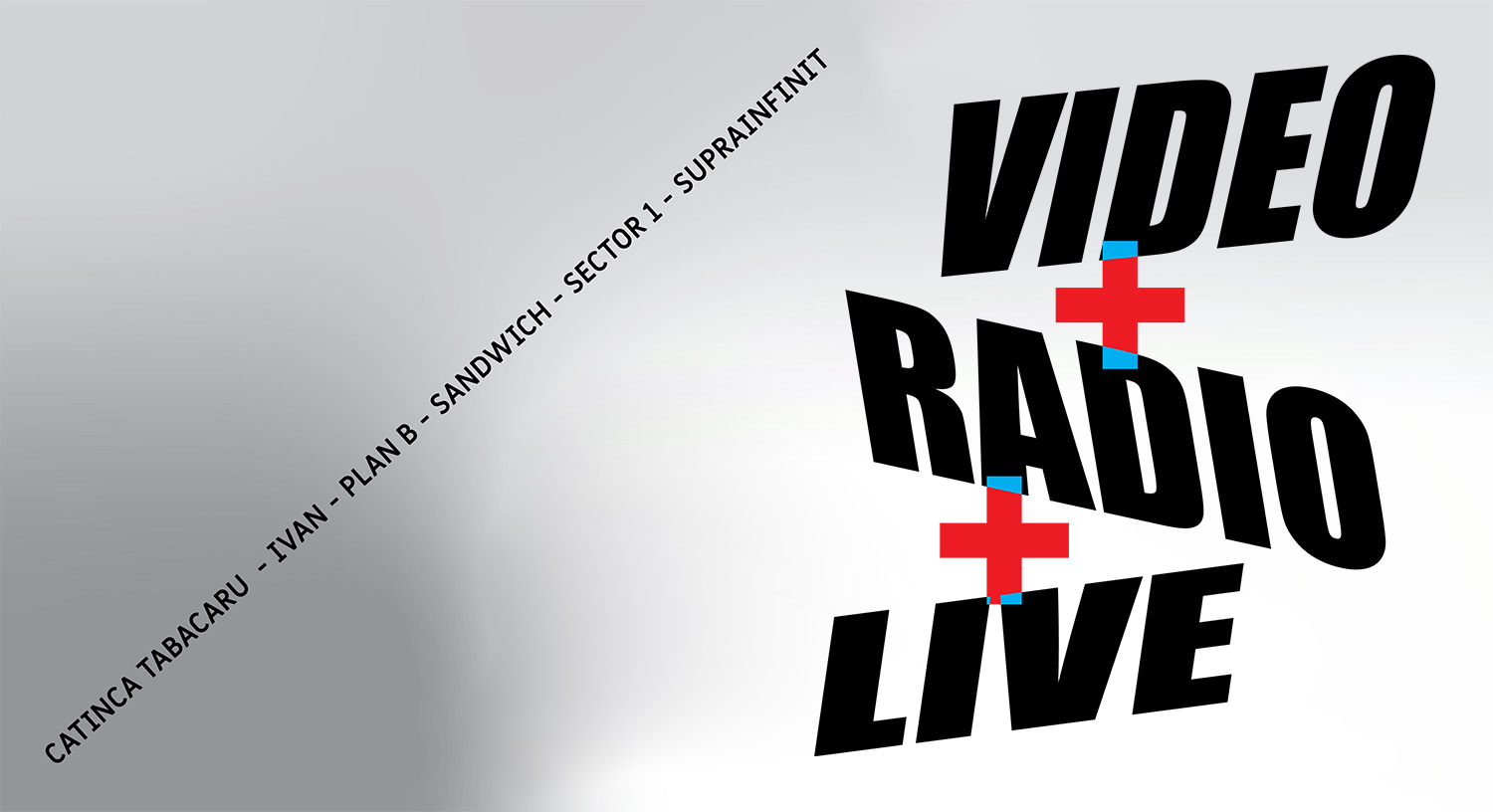
PROGRAM DURING ART ENCOUNTERS BIENNIAL 2021
The exhibition took place October 1-31 at Casa Artelor, Strada Episcop Augustin Pacha 8, Timișoara, Romania.
Opening Weekend Oct 1-3
10am-7pm | Video+Radio+Live Exhibition opens to the public
2-7pm | Apparatus 22: ongoing live performance
6-7pm. | Catinca Malaimare: live performance
7pm | Sanja Latinovic: performance broadcast live from Belgrad
Exhibition Public Hours Oct 4-31
Tues-Sun | 11am-6pm
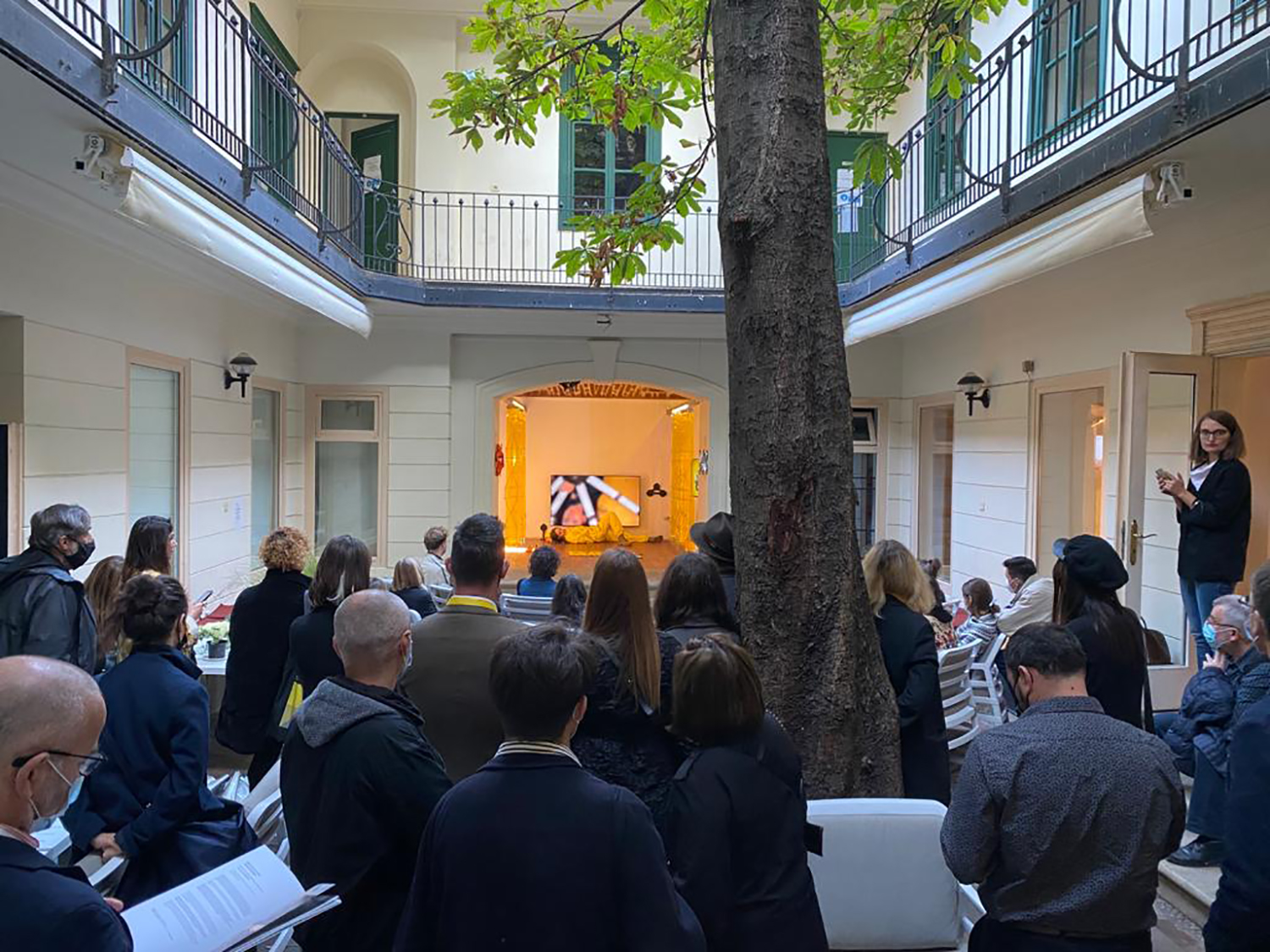
Installation Views
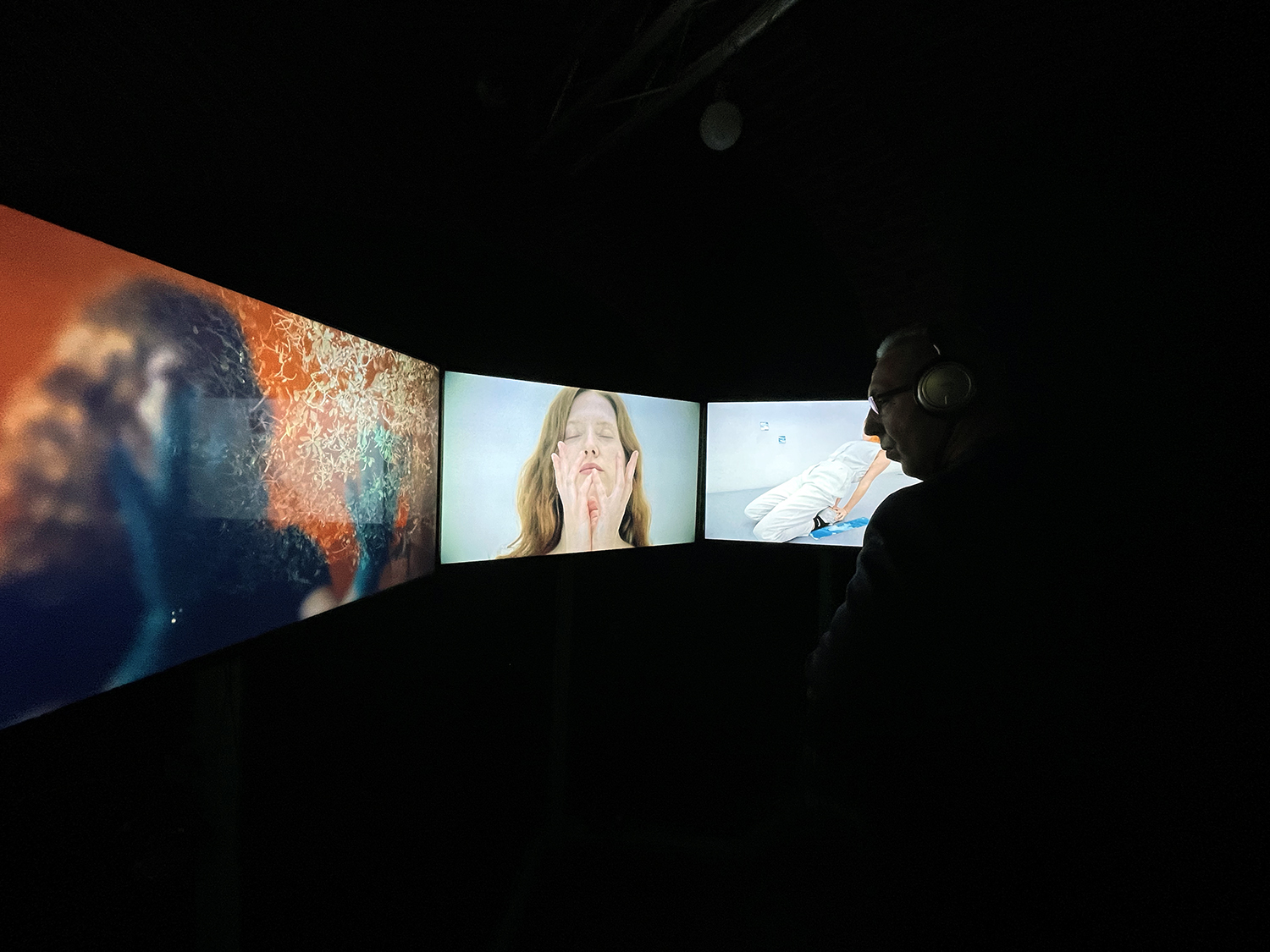 Rachel Monosov
Rachel Monosov
LIMINAL, 2020
Installation view at VIDEO+RADIO+LIVE 2021.
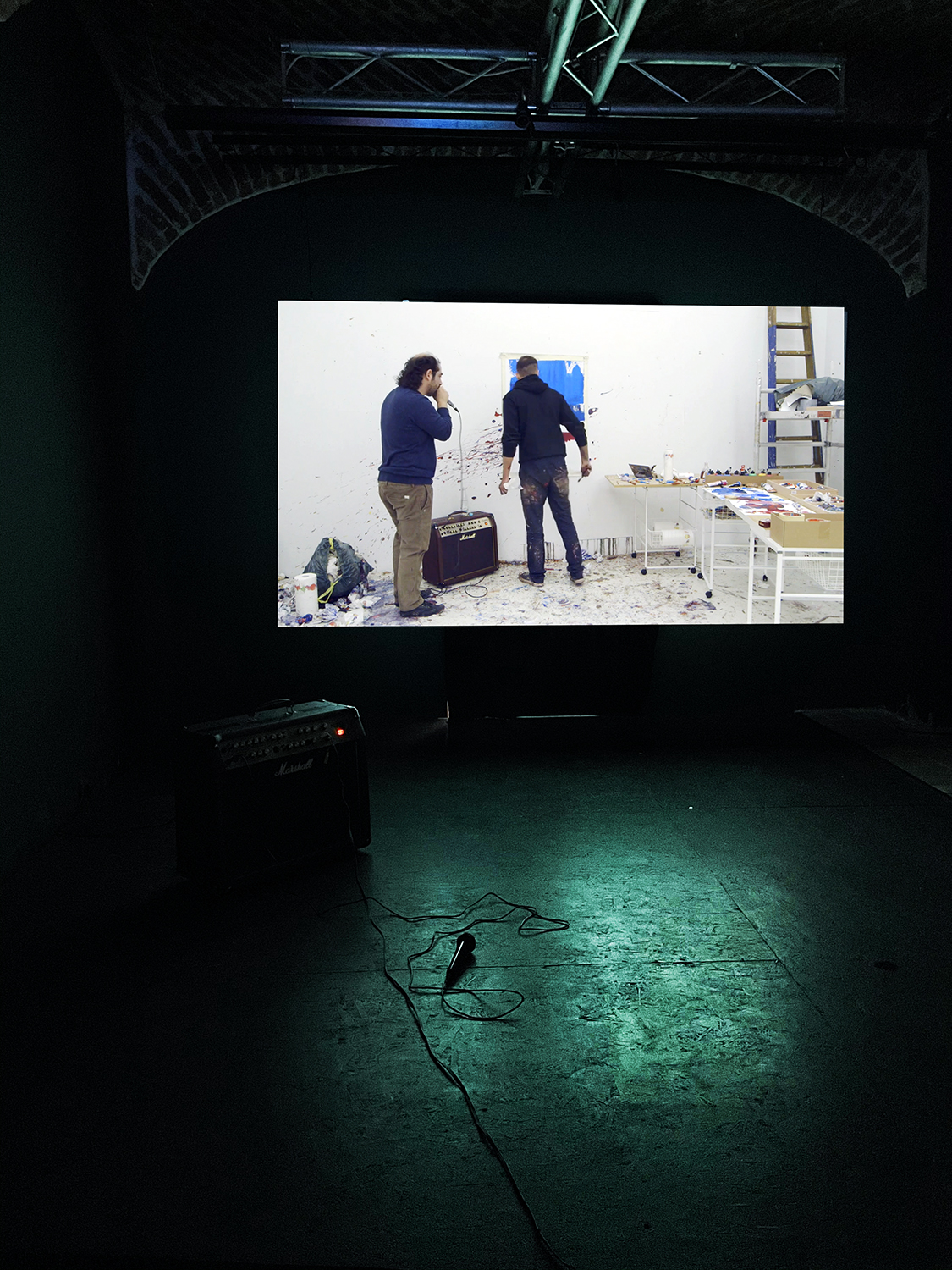 Navid Nuur and Adrian Ghenie
Navid Nuur and Adrian Ghenie
The Possibility of Purple, 2013
Installation view at VIDEO+RADIO+LIVE 2021.
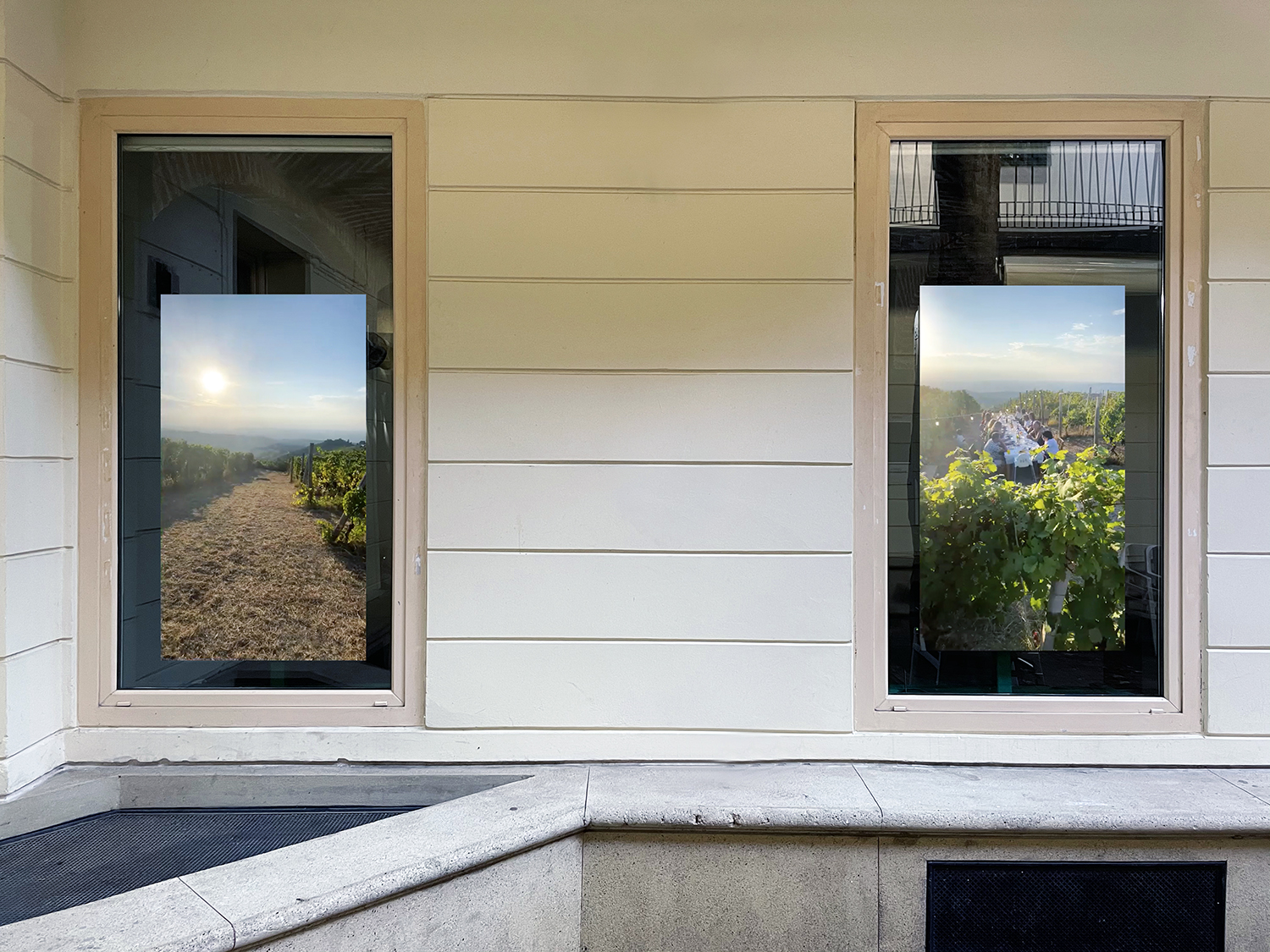 Daniela Palimariu
Daniela Palimariu
Vineyard Slips, 2021
Installation view at VIDEO+RADIO+LIVE 2021.
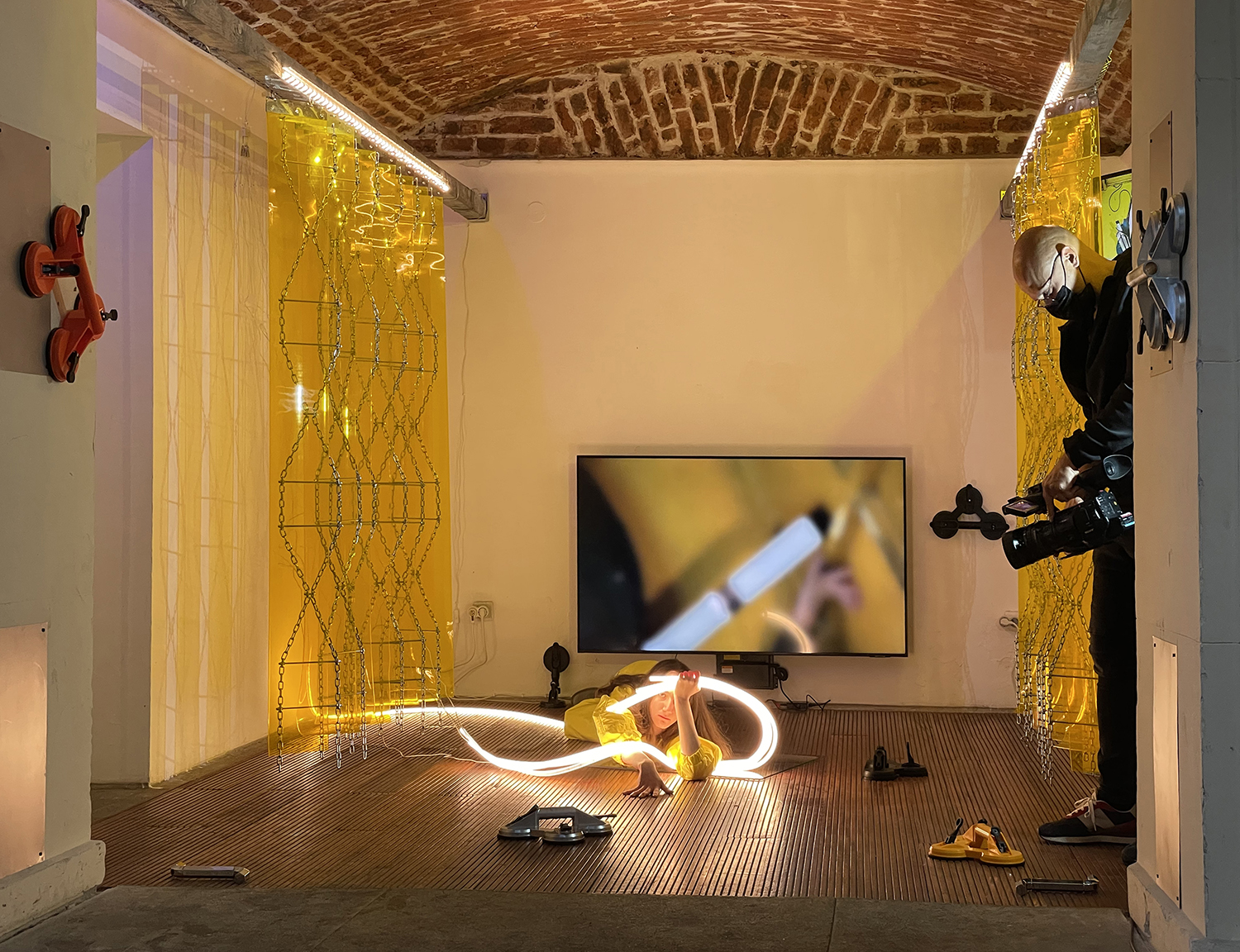 Catinca Malaimare
Catinca Malaimare
Medium Bastard Amber, 2021.
Live performance at VIDEO+RADIO+LIVE 2021.
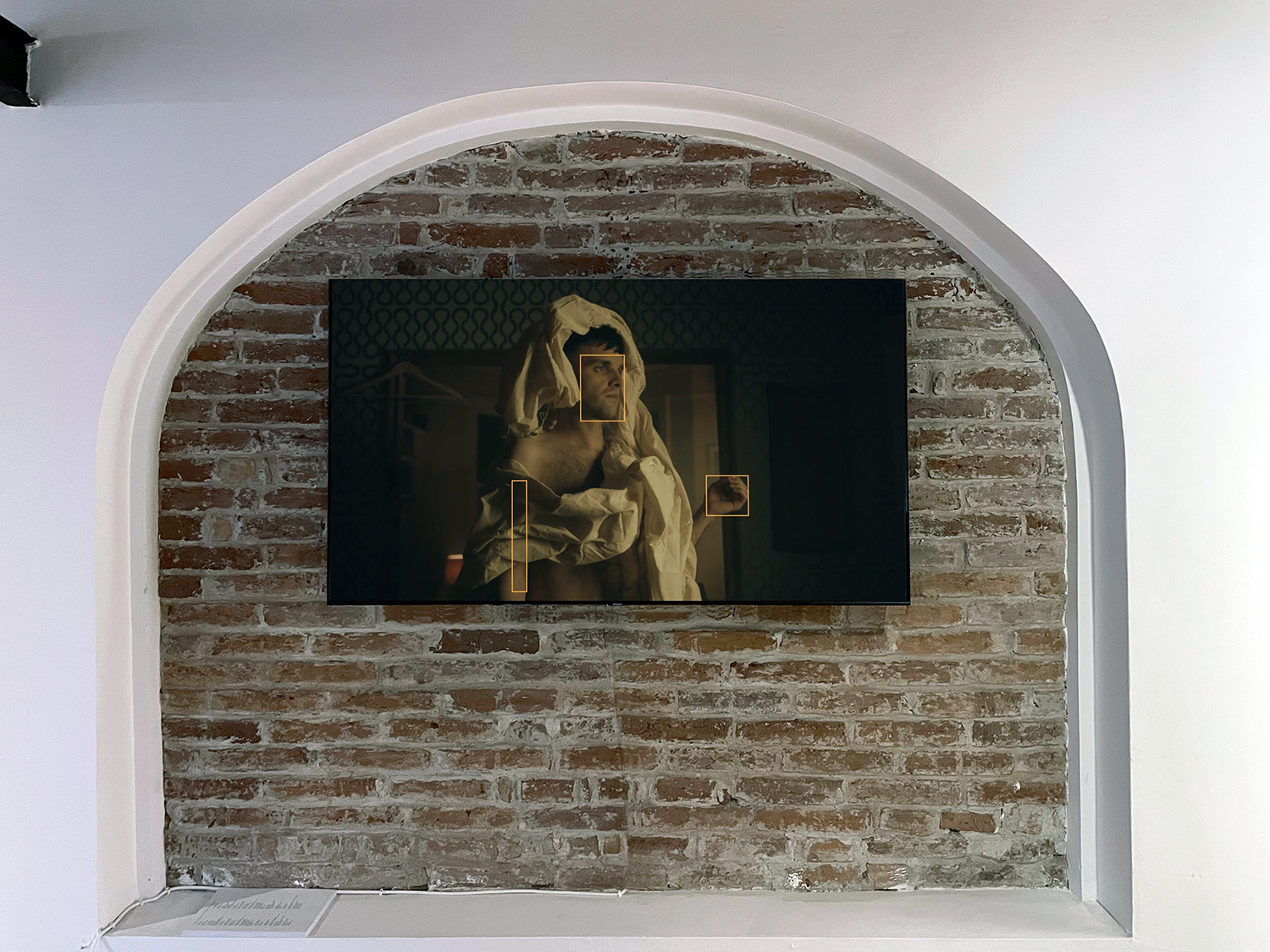 Madalina Zaharia and Ryan Ormonde Public Figure, 2021
Madalina Zaharia and Ryan Ormonde Public Figure, 2021
Video performance at VIDEO+RADIO+LIVE 2021.
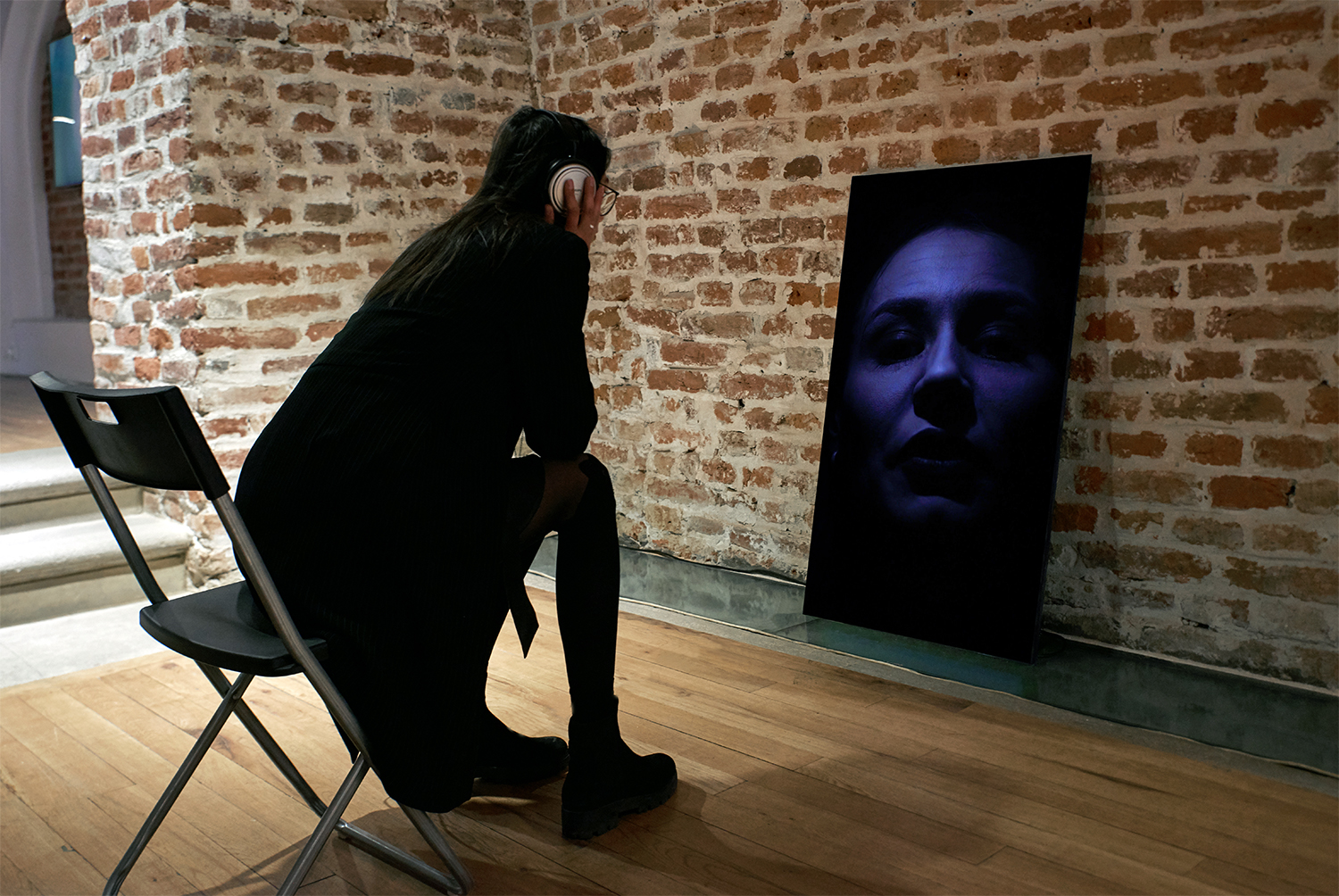 Silvia Amancei and Bogdan Armanu
Silvia Amancei and Bogdan Armanu
GAME OVER, 2021
Installation view at VIDEO+RADIO+LIVE 2021.
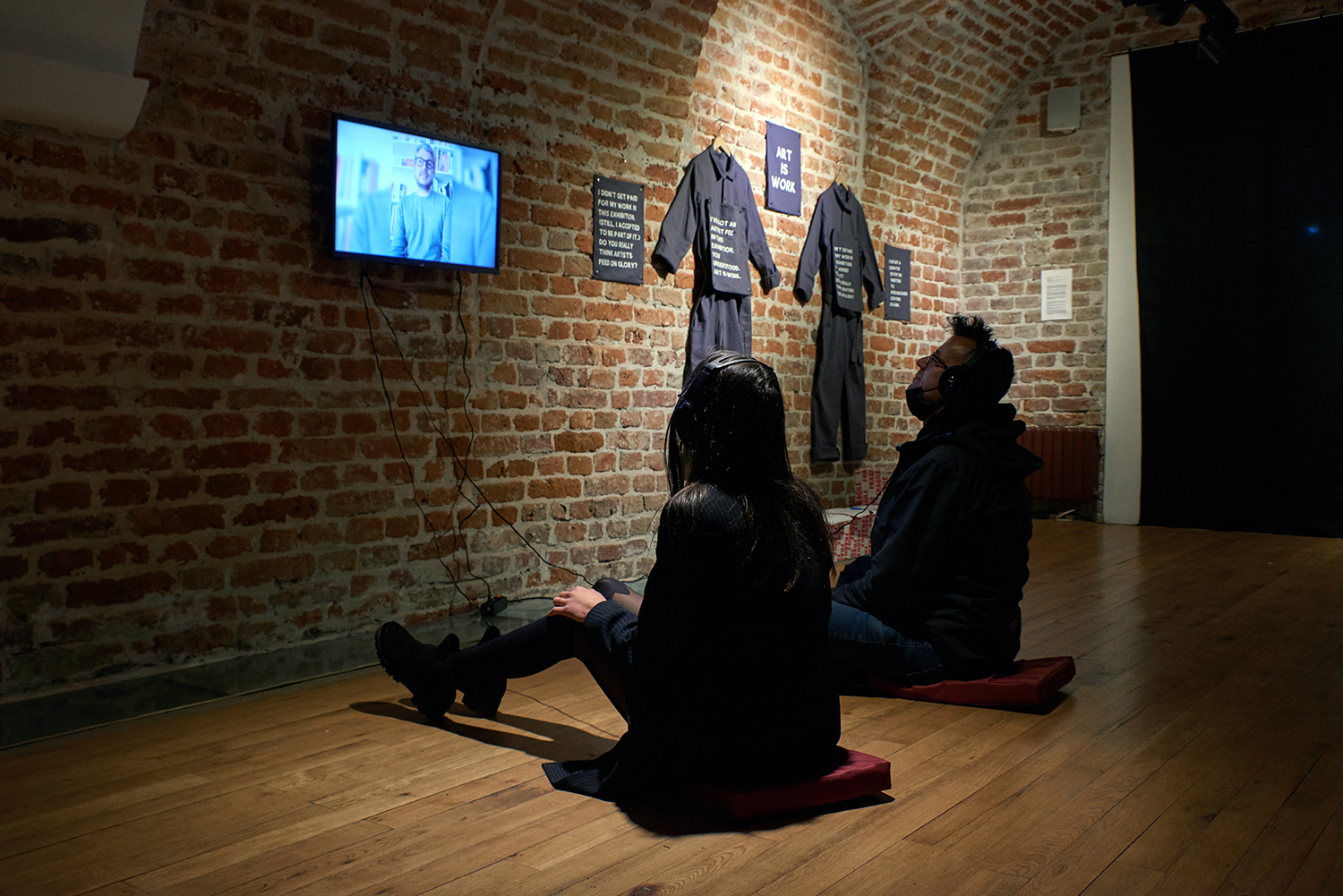 Apparatus 22
Apparatus 22
Art Is Work, 2011 – ongoing
Installation at VIDEO+RADIO+LIVE 2021.
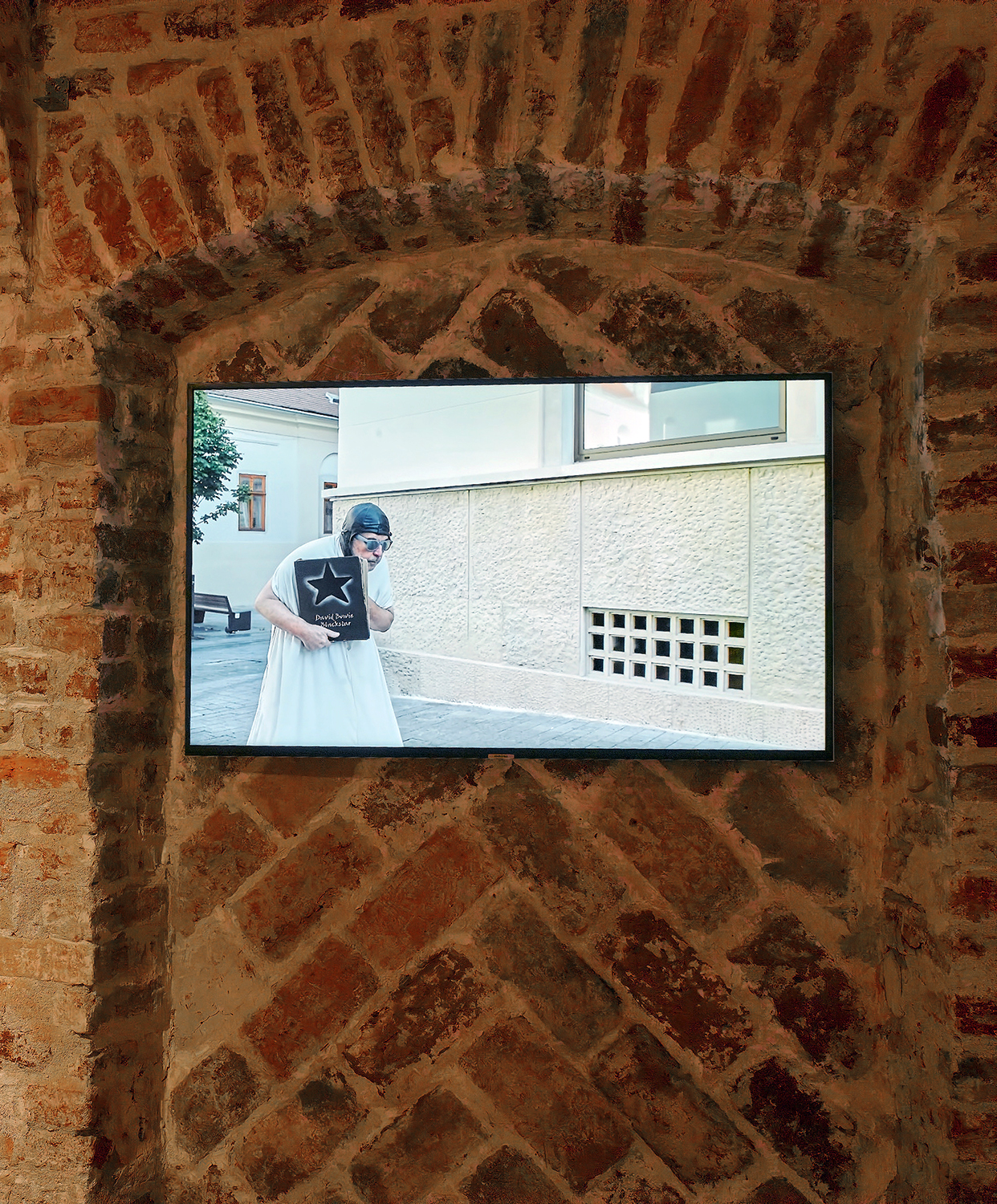 Alexandru Antik
Alexandru Antik
Memories implanted in the landscape of everyday life, 2021
Installation at VIDEO+RADIO+LIVE 2021.
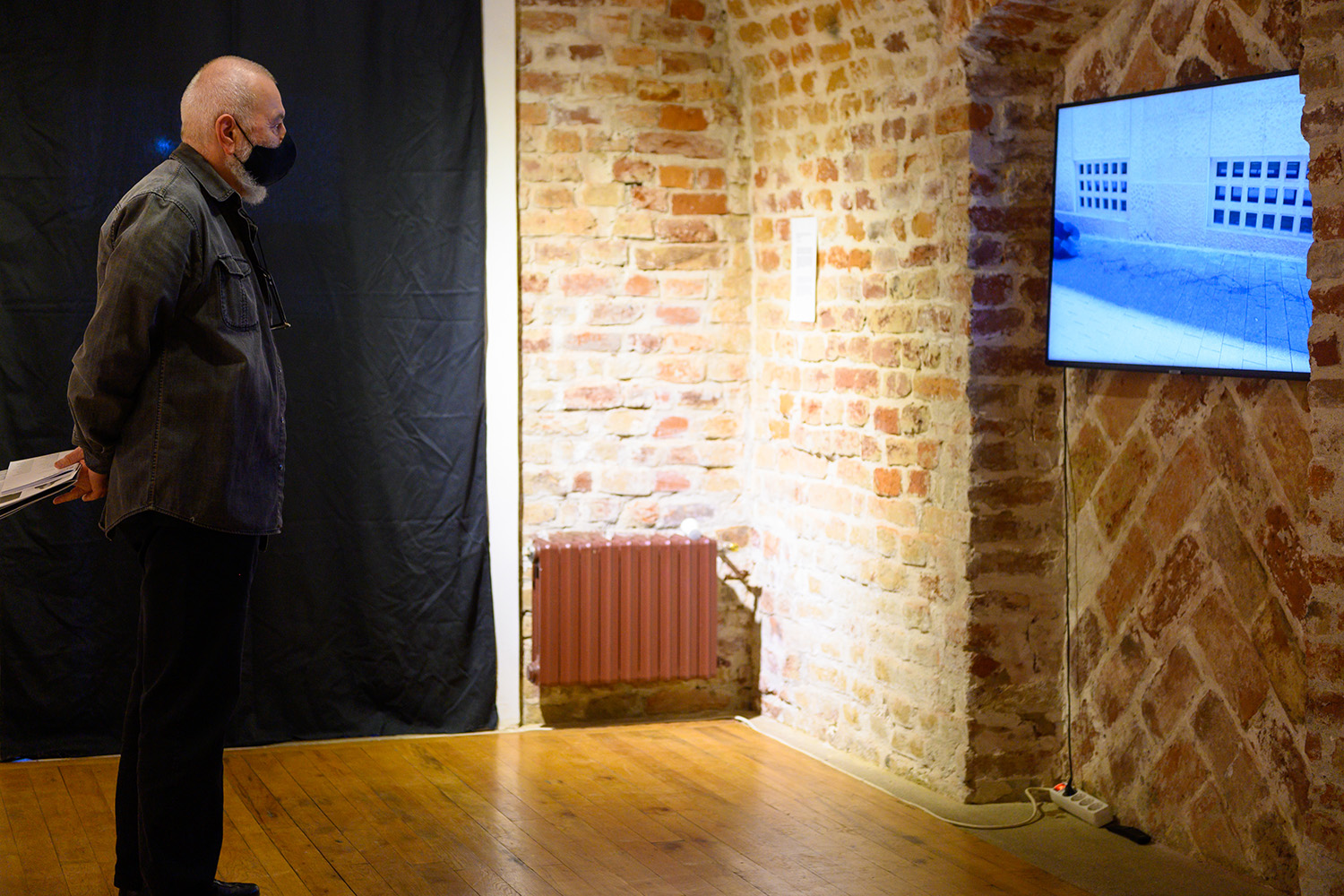 Opening night of VIDEO+RADIO+LIVE at Casa Artelor
Opening night of VIDEO+RADIO+LIVE at Casa Artelor
Photo Mihai Toth
Galleries
Catinca Tabacaru was founded in 2014 in New York City, where it became internationally recognized for its represented artists, coming from five continents, and a traveling residency program, with projects in Zimbabwe, Canada, Serbia, Nigeria, Finland and, most recently, Romania. In 2020, Tabacaru moved the gallery’s headquarters from New York to Bucharest, considering that, at this moment, it is important for the gallery’s activity to take place in a city where the art scene is burgeoning. The gallery runs a project space in Harare, Zimbabwe, active since 2015; and also functions as a platform for multidisciplinary projects, with a focus on performative practices.
Ivan is a contemporary art gallery opened in Bucharest by Marian Ivan. The gallery has acquired 15 years experience in organising solo and group shows for Romanian artists, such as Geta Brătescu, Ion Grigorescu, Paul Neagu, Lia Perjovschi, Silvia Amancei & Bogdan Armanu, Ștefan Sava, Iulia Toma, Mădălina Zaharia, as well as for foreign ones, such as Elijah Burgher, Ross Taylor and Jaro Varga; and in publishing artists books (Anca Benera & Arnold Estefan, Ștefan Sava, Geta Brătescu). In 2021 Ivan Gallery launched a new exhibition space inside Atelierele Malmaison in Bucharest.
Plan B, initiated by Mihai Pop and Adrian Ghenie, is a production and exhibition space opened in 2005 in the Romanian city of Cluj. In 2008 Plan B opened a permanent exhibition space in Berlin, coordinated by Mihaela Lutea. In 2009 Plan B was one of the initiators of the project Fabrica de Pensule / The Paintbrush Factory, a collective independent cultural center in Cluj. Plan B was the organizer of the Romanian Pavilion at the Venice Biennale in 2007, 2015 and 2019.
Sandwich started off by using the hidden potential of a residual space with the proportion of 1.5 by 8 meters, found in-between two utilitarian buildings, and is slowly but constantly expanding. Strongly believing that any restraint is a resource for finding the ultimate solution, Sandwich converts the characteristics of the chosen space into constructive limits. Sandwich works as an art space since 2016 and in 2021 has opened Sandwich Offspace at Malmaison Studios. Sandwich is focused on producing site-specific installation by both Romanian and international artists, like Thomas Tsang (HK), Abraham Cruzvillegas (MX), Mike Nelson (UK), Jin Ningning (CN), Dan Perjovschi (RO), Teodor Graur (RO), Anetta Mona Chișa & Lucia Tkacova (SK), Liliana Basarab (RO), Elena Scutaru (RO), Cătălina Gubandru (RO), etc. Sandwich is run by Alexandru Niculescu, Daniela Pălimariu and Cristian Răduță.
Sector 1, founded in 2017, has developed a program based mainly on exhibiting contemporary artists trained around the Cluj School. Through the exhibitions it organized, the gallery managed to challenge the fundamental directions of painting, drawing, sculpture and installation / object. Currently, the gallery focuses on the development of a diverse program that (re)presents emerging talents, as well as established artists, Romanian and international.
Suprainfinit founded in 2015, operates in the cultural and artistic field in Bucharest. Established to support contemporary art and culture in Romania by organizing projects mainly in the field of visual arts, Suprainfinit gallery has become in the last 6 years an important pillar sustaining the local art scene. The activity of the gallery has focused on the promotion of emerging artists from Romania, as well as international ones, through the constant production of new works and exhibitions that develop the gallery curatorial programme and the artistic scene. Since the summer of 2018, Suprainfinit has relocated to a permanent space in an area that creates a strong cultural identity, being in the vicinity of other private art galleries. The Mântuleasa neighborhood managed to create through the joint effort of the art galleries in the area a strong artistic identity and coagulate an important community.
Artists
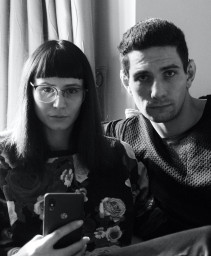 Silvia Amancei & Bogdan Armanu (b. 1991) is an artist couple working together since 2012, in the city of Iași, Romania. They both graduated from the University of Arts in Iași, respectively mural art (Amancei) and painting (Armanu), a fine art background which they transgress in their practice together with the physical and discursive limits of the object (and the labour inscribed in it) within the conceptual framework of new-media. Their artistic practice could be positioned at the border between social studies and visual art, researching for methods and examples where art and artistic means can be instrumentalised in order to overexcite the ability to look beyond capitalism and create a (common) future.
Silvia Amancei & Bogdan Armanu (b. 1991) is an artist couple working together since 2012, in the city of Iași, Romania. They both graduated from the University of Arts in Iași, respectively mural art (Amancei) and painting (Armanu), a fine art background which they transgress in their practice together with the physical and discursive limits of the object (and the labour inscribed in it) within the conceptual framework of new-media. Their artistic practice could be positioned at the border between social studies and visual art, researching for methods and examples where art and artistic means can be instrumentalised in order to overexcite the ability to look beyond capitalism and create a (common) future.
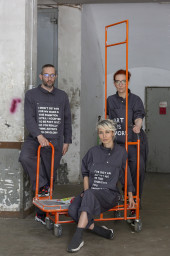 APPARATUS 22 is a transdisciplinary art collective founded in January 2011 by current members Erika Olea, Maria Farcas, and Dragos Olea, together with Ioana Nemes (1979 – 2011) in Bucharest, Romania. Since 2015 they have worked between Brussels and Bucharest. They see themselves as a collective of dreamers, researchers, poetic activists and (failed) futurologists interested in exploring the intricate relationships between economy, politics, gender studies, social movements, religion and fashion in order to understand contemporary society. A recent topic of research and reflection in the practice of Apparatus 22 is their SUPRAINFINIT universe: a world-making attempt to use hope critically in navigating present and future.
APPARATUS 22 is a transdisciplinary art collective founded in January 2011 by current members Erika Olea, Maria Farcas, and Dragos Olea, together with Ioana Nemes (1979 – 2011) in Bucharest, Romania. Since 2015 they have worked between Brussels and Bucharest. They see themselves as a collective of dreamers, researchers, poetic activists and (failed) futurologists interested in exploring the intricate relationships between economy, politics, gender studies, social movements, religion and fashion in order to understand contemporary society. A recent topic of research and reflection in the practice of Apparatus 22 is their SUPRAINFINIT universe: a world-making attempt to use hope critically in navigating present and future.
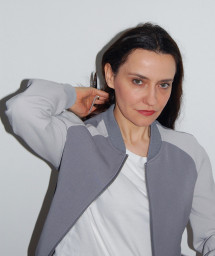 Arantxa Etcheveria (b. 1975) studied visual art at Villa Arson in Nice and set design at the National Theater in Strasbourg. Since 2013, she began developing an artistic practice related to the modernist architecture of a forgotten Bucharest, creating works that mesmerize through their elegant aesthetics. Reminding of the Bauhaus style, her work, the result of meditative reflection, is not intended to reflect reality and yet, the reality guides it in a symbolic way. The architecture and its grids in Etcheverria’s compositions present us with something real while giving free rein to the ramblings of thought.
Arantxa Etcheveria (b. 1975) studied visual art at Villa Arson in Nice and set design at the National Theater in Strasbourg. Since 2013, she began developing an artistic practice related to the modernist architecture of a forgotten Bucharest, creating works that mesmerize through their elegant aesthetics. Reminding of the Bauhaus style, her work, the result of meditative reflection, is not intended to reflect reality and yet, the reality guides it in a symbolic way. The architecture and its grids in Etcheverria’s compositions present us with something real while giving free rein to the ramblings of thought.
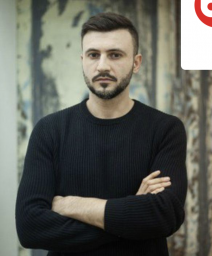 Adrian Ghenie (b. 1977) surveys and subverts historical and artistic narratives through his paintings, which aim to unearth feelings of vulnerability, frustration, or desire, and often draw on human experience and ideas of the collective unconscious. Ghenie’s paintings developed during this time to include themes of history, memory, and the legacy of villainous historical figures, particularly of his native Romania. These figures, largely derived from mid-twentieth-century historical sources, appear in haunting interiors as dreamlike or cinematic vignettes. Ghenie also began to appropriate tropes from slapstick film, manifesting in his Pie Fight paintings that, in a confluence of figuration and abstraction, depict historical or cinematic figures whose faces are freshly slathered with a custard pie per the comedy of the Three Stooges. His recent work is driven by historical conflict between the irrational and rational, particularly in key ideas or moments that have incited social tumult. These tensions manifest in Ghenie’s paintings through a confluence of abstraction and representation and extend to collage, assemblage and installation.
Adrian Ghenie (b. 1977) surveys and subverts historical and artistic narratives through his paintings, which aim to unearth feelings of vulnerability, frustration, or desire, and often draw on human experience and ideas of the collective unconscious. Ghenie’s paintings developed during this time to include themes of history, memory, and the legacy of villainous historical figures, particularly of his native Romania. These figures, largely derived from mid-twentieth-century historical sources, appear in haunting interiors as dreamlike or cinematic vignettes. Ghenie also began to appropriate tropes from slapstick film, manifesting in his Pie Fight paintings that, in a confluence of figuration and abstraction, depict historical or cinematic figures whose faces are freshly slathered with a custard pie per the comedy of the Three Stooges. His recent work is driven by historical conflict between the irrational and rational, particularly in key ideas or moments that have incited social tumult. These tensions manifest in Ghenie’s paintings through a confluence of abstraction and representation and extend to collage, assemblage and installation.
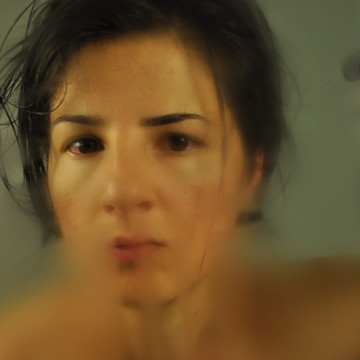 Sanja Latinović (b. 1983), although a sculptor by vocation, focuses her work mainly on performance, video and photography, choosing those carefully as the fields of her artistic expression in order to question the very medium of sculpture by exploring its transformative potential in the relations matter-space-form-idea. Sanja’s thematic preoccupations are mainly about problematizing the complex functioning of an individual in today’s world, our everyday confrontations with numerous and various forms of social determinations, imperatives, pressures. Dealing more with the emotionally psychological dimension of those relations, the artist proposes and articulates her own views through unpretentious, simplified visual solutions/performances forming them into a kind of metaphores about syndromes, states and processes that characterise the complex global image of the society.
Sanja Latinović (b. 1983), although a sculptor by vocation, focuses her work mainly on performance, video and photography, choosing those carefully as the fields of her artistic expression in order to question the very medium of sculpture by exploring its transformative potential in the relations matter-space-form-idea. Sanja’s thematic preoccupations are mainly about problematizing the complex functioning of an individual in today’s world, our everyday confrontations with numerous and various forms of social determinations, imperatives, pressures. Dealing more with the emotionally psychological dimension of those relations, the artist proposes and articulates her own views through unpretentious, simplified visual solutions/performances forming them into a kind of metaphores about syndromes, states and processes that characterise the complex global image of the society.
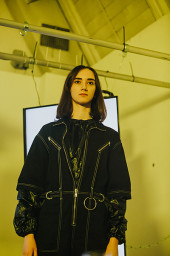 Catinca Malaimare (b. 1996) is a London-based Romanian artist. She is currently completing her postgraduate studies at The Royal Academy of Arts. Performing alongside anthropomorphised technologies, Malaimare’s choreography manifests our intimate relationship with photographic tools and the screens onto which they project our visages. She was awarded a research residency at TUA, Tokyo (2019), the Ivor Rey Travel Bursary for a residency in Paris (2020) and recently participated in the symposium residency Staycation, a collaborative project in Bucharest between CTG Collective & Sandwich.
Catinca Malaimare (b. 1996) is a London-based Romanian artist. She is currently completing her postgraduate studies at The Royal Academy of Arts. Performing alongside anthropomorphised technologies, Malaimare’s choreography manifests our intimate relationship with photographic tools and the screens onto which they project our visages. She was awarded a research residency at TUA, Tokyo (2019), the Ivor Rey Travel Bursary for a residency in Paris (2020) and recently participated in the symposium residency Staycation, a collaborative project in Bucharest between CTG Collective & Sandwich.
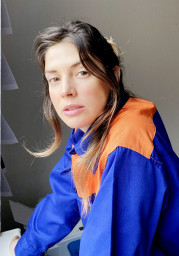 Rachel Monosov (b. 1987) works in performance, photography, video, and sculpture. By delving into cultural notions of alienation, territorial belonging, and identity, she reflects a rootless present rife with broader social implications. She constructs entire worlds around her subjects, which function pursuant to their own set of laws. Her personal biography is weaved throughout, loading the work with social and political concepts echoing historical events. Monosov is a co-founder of the CTG Collective, she was born in Russia, grew up in Israel, studied in the USA and Belgium, and currently lives and works in Berlin.
Rachel Monosov (b. 1987) works in performance, photography, video, and sculpture. By delving into cultural notions of alienation, territorial belonging, and identity, she reflects a rootless present rife with broader social implications. She constructs entire worlds around her subjects, which function pursuant to their own set of laws. Her personal biography is weaved throughout, loading the work with social and political concepts echoing historical events. Monosov is a co-founder of the CTG Collective, she was born in Russia, grew up in Israel, studied in the USA and Belgium, and currently lives and works in Berlin.
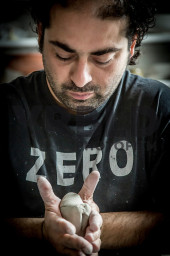 Navid Nuur (b. 1976) lives and works in The Hague. The way in which Nuur relates to material, the space around him and his observations therein, can almost be regarded as devout. The attention for detail and the careful fine-tuning of the various elements of a work or exhibition make the audience part of an ‘inner’ world. In Nuur’s work – although very conceptual at first sight – a very personal visual problem becomes the central question. What Nuur has in common with the conceptual artists from the sixties is the relation between concept and form. Form for him however, is not necessarily the result of the idea, but materializes through a subjective program of requirements or rules in which intuition has the upper hand. He applies concepts that often relate to a temporary in-between state that places his work between the audience and an often abstract phenomenon, such as light, energy, air, or ‘rest space’. Nuur’s form-language and meaning are therefore principally purely process-oriented.
Navid Nuur (b. 1976) lives and works in The Hague. The way in which Nuur relates to material, the space around him and his observations therein, can almost be regarded as devout. The attention for detail and the careful fine-tuning of the various elements of a work or exhibition make the audience part of an ‘inner’ world. In Nuur’s work – although very conceptual at first sight – a very personal visual problem becomes the central question. What Nuur has in common with the conceptual artists from the sixties is the relation between concept and form. Form for him however, is not necessarily the result of the idea, but materializes through a subjective program of requirements or rules in which intuition has the upper hand. He applies concepts that often relate to a temporary in-between state that places his work between the audience and an often abstract phenomenon, such as light, energy, air, or ‘rest space’. Nuur’s form-language and meaning are therefore principally purely process-oriented.
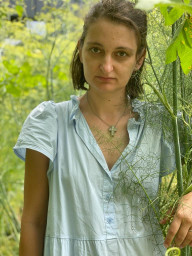 Daniela Palimariu (b. 1986) works as an artist in Bucharest, Romania. Her art practice includes livable environments and objects, installations, semi-private events and drawings, all of which understate the ambiguity of human relations, the need for personal space, play and daily subversions. Palimariu is a co-founder of the Bucharest-based artist-run space Sandwich founded in 2016.
Daniela Palimariu (b. 1986) works as an artist in Bucharest, Romania. Her art practice includes livable environments and objects, installations, semi-private events and drawings, all of which understate the ambiguity of human relations, the need for personal space, play and daily subversions. Palimariu is a co-founder of the Bucharest-based artist-run space Sandwich founded in 2016.
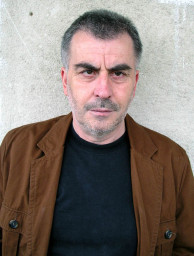 Alexandru Antik Sándor (b. 1950) is recognized for his experimental activity in the area of actionism and video installation. His artistic practice took a conceptual approach starting from the 1970s, demystifying the role of the artistic object and of its author. Antik’s works are characterized by varying artistic mediums (object, installation, actionism performance, video, photography), evoking, in a systematic way, the problem of memory and restoration. Many of his works have an ephemeral life span – performances, installations, actionism works that were not always documented. He is an active member of the experimental art and performance group in Cluj, coordinated by Ana Lupaș, which is internationally recognized as an innovative, critical and strong figure in contemporary art. Having participated in the Venice Biennale in 1999, as well as in countless exhibitions and performance and multimedia festivals, Antik is known as one of the key voices in Romanian experimental art.
Alexandru Antik Sándor (b. 1950) is recognized for his experimental activity in the area of actionism and video installation. His artistic practice took a conceptual approach starting from the 1970s, demystifying the role of the artistic object and of its author. Antik’s works are characterized by varying artistic mediums (object, installation, actionism performance, video, photography), evoking, in a systematic way, the problem of memory and restoration. Many of his works have an ephemeral life span – performances, installations, actionism works that were not always documented. He is an active member of the experimental art and performance group in Cluj, coordinated by Ana Lupaș, which is internationally recognized as an innovative, critical and strong figure in contemporary art. Having participated in the Venice Biennale in 1999, as well as in countless exhibitions and performance and multimedia festivals, Antik is known as one of the key voices in Romanian experimental art.
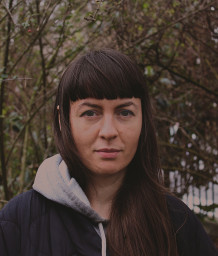 Madalina Zaharia’s (b. 1985) work focuses on the provocative relationship between design and fiction and explores the unavoidable inadequacy that arises when imagining and representation collide. Her practice reflects and contemplates a certain absurdity and visual incongruity by intentionally flattening a myriad of symbols and cultural references into one, locking them all together inside the smooth and carefully composed decorum of the artwork. The very fine line between art, design and storytelling is constantly challenged and confronted by the language and visual vocabulary employed within her creative actions, transforming the studio and the gallery into spaces for discourse and abstract entertainment, arenas animated by gestures, objects and meaningful shapes. She is particularly interested in the way in which personal experience and fiction could influence and instruct our relationship with reality, exploring the very way in which we use self-analysis and reflection in order to construct and produce meaning.
Madalina Zaharia’s (b. 1985) work focuses on the provocative relationship between design and fiction and explores the unavoidable inadequacy that arises when imagining and representation collide. Her practice reflects and contemplates a certain absurdity and visual incongruity by intentionally flattening a myriad of symbols and cultural references into one, locking them all together inside the smooth and carefully composed decorum of the artwork. The very fine line between art, design and storytelling is constantly challenged and confronted by the language and visual vocabulary employed within her creative actions, transforming the studio and the gallery into spaces for discourse and abstract entertainment, arenas animated by gestures, objects and meaningful shapes. She is particularly interested in the way in which personal experience and fiction could influence and instruct our relationship with reality, exploring the very way in which we use self-analysis and reflection in order to construct and produce meaning.
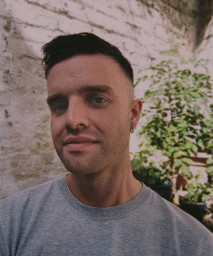 Ryan Ormonde is a poet from London and co-founder of performance collective press free press. Ormonde’s second poetry pamphlet, a meditation on the effect of the medium of film on the written word, was described by Rosie Breese in Sabotage Reviews as ‘wonderfully unpredictable; a wild ride through the poet’s wordplay-world and the questioning of meaning itself’. In the last year, Ormonde has contributed poems to SPAM, Spoonfeed, Osmosis and Permeable Barrier, collaborated on a video poem with poet Karenjit Sandhu for Magma and produced the zine-length poem ‘Ray’s Marble Race’. Ormonde is a contributing artist to Impermanence Dance’s Decade project.
Ryan Ormonde is a poet from London and co-founder of performance collective press free press. Ormonde’s second poetry pamphlet, a meditation on the effect of the medium of film on the written word, was described by Rosie Breese in Sabotage Reviews as ‘wonderfully unpredictable; a wild ride through the poet’s wordplay-world and the questioning of meaning itself’. In the last year, Ormonde has contributed poems to SPAM, Spoonfeed, Osmosis and Permeable Barrier, collaborated on a video poem with poet Karenjit Sandhu for Magma and produced the zine-length poem ‘Ray’s Marble Race’. Ormonde is a contributing artist to Impermanence Dance’s Decade project.
Narrator
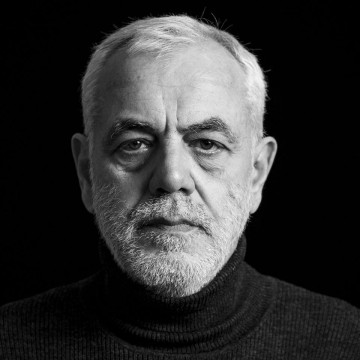 Bogdan Ghiu (b. 1958) is a poet and writer; and a principal members of Generation 80 and the former Cenaclul de Luni (Monday Cenacle), both important literary movements and literary groups of Eastern Europe’s the last decade of communism. Multilaterally, he writes and publishes poetry, essays (on literature, philosophy, media, contemporary art, architecture, translation theory and pedagogy, politics) and translations (over 70) of French philosophy and literature. In 2011, together with the curators Maria Rus Bojan and Ami Barak, he represented Romania at the Venice Biennale, and since 2011 he has been the general curator of the Bucharest triennial of architecture East Centric. His most recent books are the volumes of poetry Strîngerea armelor (Metoda) (“Gathering Arms (The Method)”), 2021, and Cu Orice e posibil (“With Anything (Is) Possible”), 2019; and the essays Pandemiocrația (“Pandemiocracy”), 2020, Totul trebuie tradus. Noua paradigmă (un manifest) (“Everything Must Be Translated. The New Paradigm (a Manifesto)”), 2015, and Linia de producție: lucrând cu arta (“The Production Line: Working with Art”), 2014. He has collaborated with visual artists including Thomas Hirschhorn, Daniel Knorr, Victor Man, and Miklós Onucsán.
Bogdan Ghiu (b. 1958) is a poet and writer; and a principal members of Generation 80 and the former Cenaclul de Luni (Monday Cenacle), both important literary movements and literary groups of Eastern Europe’s the last decade of communism. Multilaterally, he writes and publishes poetry, essays (on literature, philosophy, media, contemporary art, architecture, translation theory and pedagogy, politics) and translations (over 70) of French philosophy and literature. In 2011, together with the curators Maria Rus Bojan and Ami Barak, he represented Romania at the Venice Biennale, and since 2011 he has been the general curator of the Bucharest triennial of architecture East Centric. His most recent books are the volumes of poetry Strîngerea armelor (Metoda) (“Gathering Arms (The Method)”), 2021, and Cu Orice e posibil (“With Anything (Is) Possible”), 2019; and the essays Pandemiocrația (“Pandemiocracy”), 2020, Totul trebuie tradus. Noua paradigmă (un manifest) (“Everything Must Be Translated. The New Paradigm (a Manifesto)”), 2015, and Linia de producție: lucrând cu arta (“The Production Line: Working with Art”), 2014. He has collaborated with visual artists including Thomas Hirschhorn, Daniel Knorr, Victor Man, and Miklós Onucsán.
Partners
Art Encounters
Casa Artelor Timisoara
Direcția Județeană pentru Cultură Timiș
Radio Guerilla
Radio Romania Cultural
Zile si Nopti
Ibis Timisoara
1664 Kronenbourg Blanc
VIDEO+RADIO+LIVE is co-financed by:
AFCN The project is co-financed by the Administration of the National Cultural Fund. The program does not necessarily represent the position of the Administration of the National Cultural Fund. The AFCN is not responsible for the content of the program or the manner in which the results of the program may be used. These are entirely the responsibility of the funding recipient.
Primăria Municipiului Timișoara și Consiliul Local Timişoara VIDEO+RADIO+LIVE is generously supported by Timişoara City Hall and the Timişoara Local Council. The project does not necessarily represent the position of the Timişoara City Hall and the Timişoara Local Council. The content of the project and the manner in which the results of the program can be used are the sole responsibility of the authors and the beneficiary of the funding. Timişoara City Hall and Timişoara Local Council are not responsible for the content of the material and how it could be used.
Context
In the communist Romania of the 1960s, artists begin making performative video works in their studios as a reaction against the impossibility of gathering in public spaces. Considered only a place of passage, of transition, inaccessible to the will of the people, the public space is boldly appropriated by artists after the revolution.
In the 1990s, we witnessed an explosion of performance art events − such as the Zona, Periferic, AnnART festivals − and a growing audience for this medium of expression. Between the 1990s and 2000s, performance art evolved as a form of avant-garde, with an accelerated development in the last decade. This tendency was interrupted by the pandemic, which caused the loss of direct contact between art and its public, often mediated by the online field. The imposed limitations paradoxically contributed to innovations in performance art. Artists found new ways of manifestation, using the screen as the stage, and the camera lens as their audience.
Today, we are approaching the end of the quarantine / post-isolation period, a time when gatherings are allowed but restricted. Once more, contemporary performance art is forced to adapt to a hybrid reality, allowing for new ways of expression, but also bringing persistent constraints. By presenting both live performance works − a practice rather related to the pre-pandemic period − and video-performances, Video+Radio+Live offers a vision of this hybridity, which can coexist and adapt to the geographical, social and political limitations of the moment. Each performance work is made available as online video and audio format (radio broadcasting and podcast); the differentiated experience of the two types of audience (physical and virtual) mirrors the current situation of life and art. Thus, the project highlights the concept of adaptability omnipresent in today’s society.
By exposing the public to a hybrid communication of art (video, live, online, radio), and involving it in dialogues about the changes in both art and life, Video+Radio+Live encourages community activation through culture and the creation of a dialogue between audience, organizers and guests. The six partners are co-curators of the project, collaborating in defining the curatorial concept, in the selection of artists and in the effective realization of the exhibition. The project is a collaboration between galleries, thus discouraging the idea of competition and considering that, especially in times of crisis, solidarity must be the main working method.
Presence, Representation and Perception – Negotiating What Is Exhibited
What can we see in the absence of images? How can we become more present? A diaristic review.
– Daniela Custrin
On September 30 I went to the collective opening of VIDEO+RADIO+LIVE, organized by a number of Romanian contemporary art galleries – Catinca Tabacaru, Ivan, Plan B, Sandwich, Sector 1, and Suprainfinit – at Casa Artelor in Timișoara, as an associated event of the Art Encounters Biennial 2021. The event brings together video works, as well as live and recorded performance pieces, adapted to the current pandemic context, questioning and discovering new ways of intervening in a space in the absence of physical interaction or presence. Video and radio act as bridges between presented and represented forms, towards a form of redefining presence, connecting movement and sense, the visual and the somatic.
Bogdan Ghiu was the event’s special guest. His role was to give an account of the events, on the radio, in podcasts, and in a special recording of his narrativizations, which will later be distributed as a USB stick / disk. One notes a shift in perception when it comes to representation and interaction, reconsidering the occurrence of physical presence in exhibition spaces, which needs to be rethought and replaced with a series of new dispositions of motion, affect, sense, but also with a vocabulary created in situations where the participatory dimension becomes impossible within the unitary meaning of global events. Through his call to narrative discourse, Bogdan Ghiu’s proposal reconsiders this paradigm of participation in which the materiality, exhibition, and dominance of the visual is negotiated. What are we able to see in the absence of images? How can we become more present?
At the event, I decided to also take part in this new experimental and necessary way of seeing and participating. At that point I thought it would be interesting, upon contact with the space, to propose a new form of representing the exhibition, namely in the form of diary entries, containing personal reflections and notes, for which I will use the residues of my initial hermeneutics, the thoughts and notes I took throughout the nights.
The two main exhibition spaces, together with the garden in the inner courtyard, offer different means and dynamics of coming into contact with the works, which cross the barrier formed by the space’s architecture in a kind of circuit of frames, of screens that beckon you towards them, that you want to approach, rigorously, carefully, in turn. This disposition to see through the mediation of screens offers the possibility of certain resumptions, of contaminations of the present event with the archived one, of the sense of security that what you lost can always be resumed. The video works offer a multiplicity of contexts and visions that lend each other space, being united at the same time by a core idea, that of being visible in a context where participation and interaction are constrained and diminished by external events, often transformed from live events into recordings.
The productions displayed in the exhibition spaces, in the galleries, bring together, following Hito Steyerl, spectators-seekers-researchers, who are distributed throughout the gallery space in an incoherent fashion, forming a silent, absorbed, atomized crowd. I feel the presence of the visitors’ search, and in the middle of the commotion I discover a feeling of calmness before a screen, where I stop. I see two parallel frames dominated by the complementary colors red and blue, and a female character that appears, first in turn, then simultaneously, in the two frames, dressed in blue and red respectively, carrying a wooden pole on her shoulder. In the background I see a sculpture in the shape of a door. I learn that artist Arantxa Etchevveria’s Red Door and Blue Door starts from a different work – Apocalipsă/Beatus – a series of photomontages inspired by the representations of Spanish Beatuses in the 12th century. The video shows the performative display of a guard before a door, in a linear pose which requires concentration, awareness, meditation, and daydreaming.
Performer Ada Mușat’s very clear position erodes my attention, which turns into something closer to rest, a state that translates in terms of reflection, physical stillness, quietness, and wakefulness. The hubbub around me is replaced by stillness, and with the help of the formal techniques with which the spectator must divide their gaze, their attention from one frame to the next, with an unlikely difference, I notice an inherent, unclear dynamics between the two frames, which seem to rock you. On a phenomenological level, the slowed-down, static frames offer one the necessary time to receive an impression of the character and object, of the elements one directs their attention towards, analyzing them and transforming this technique of temporal duration into a technique of meditative observation. Starting from Deleuze’s division between movement-image and movement-time, I am able to understand duration and stillness within the episteme of a potential materiality which is given by a durational imperative and a time consumable in various structures and forms through which we come to interpret, mediate, and, perhaps, understand. I associate Arantxa Etchevveria’s work with terms like landscape, meditation, stasis, safety, position, cessation, stop, composition, silence.
In this moment two things draw my attention, and I feel I have to move: a screen nearby in which I notice another pole carried by artist Sanja Latinović on both shoulders, which makes me turn my gaze back to the screen I have just left in order to make sure that the pole I just saw did not somehow magically cross over into the other screen, onto other shoulders, and I also notice a powerful, yellow, orange light from a different screen farther away, which at this point I only observe from a distance.
The artist carries on her shoulders a yoke with two buckets of water, which she uses to water some dry suffering trees that are in a state of falling apart. She chooses water as her primary element, with its characteristic properties in the metabolic processes of trees, thereby intensifying the transfer of consecrated features of the exhibition space, which remains rigid and inflexible, through which the difficulty of achieving plant germination and growth in artificial, electrically lit, neutral spaces is brought into discussion. I remember an essay by researcher Audronė Žukauskaitė in which she speaks about the perceived need of creating a distinction between human and non-human by specifically isolating nature in botanical gardens, zoos, safaris, greenhouses, and museums, where I can observe the difference between myself and the Other, while at the same time being able to comfortably reinvent and assert my own humanity through the freedom I possess, that of choosing whether to act (or not), whether to repair (or not).
Trees are forced into contact with human environments that are, generally, unwelcoming for them, because of the imposed artificial conditions, which normalizes the fundamental virtue of temporarily using and objectifying nature in order to understand how, when, and in what conditions we are able to help. By investing in a series of tardy human actions, the artist seems to emphasize a brutal statement where we are confronted with our actions, with the stakes of the artistic act we have taken part in and which intervenes as a delayed reaction, a deferred answer.
And at this point I write down: Why dying trees? Where from? How? If the goal of the performance was becoming aware of our current crises – of an ecological nature as well as others – by depriving trees of their natural conditions, especially those in a state of decay, is Latinović not contradicting her own statement? Or is this an acknowledged self-critique? Is the lesser evil towards the greater good? I read the text written by Jelena Veljković Wilson in the exhibition catalogue and I stop at the following sentence: “Her works aim to trigger ruminations on concepts such as duty, need, and neglect.”
I realize that right now I could easily feel
duty,
need,
neglect.
I move on and arrive at the screen I had noticed, which emanates orange light and shows Madalina Zaharia and poet Ryan Ormonde’s work Public Figure. Four poems, associated with domestic images, invaded by a garish orange, by oranges, familiar objects, but also by a corporeal language engaged in fixed, scripted positions, intervene in the space through sound and sight. The staging of a text-body and a reflection-movement directs one towards understanding fluidity, of form in motion, of corporeal slowing-down. Ryan Ormonde’s movements are directed towards a means of knowing the character, both in an anticipated and programmed form that you can get used to quickly, in which getting close to them resembles a given of the constitutive formal elements (close-ups of the performer’s eye, vibrating music, soothing voice, rectangular framings of elements constituting the body and things around), as well as in a form where the attention is directed towards a new sensoriality, that of the incongruence between voice and body, between language and movement, to the detriment of versification as the emphasis of each sequence. I feel the need to associate the voice with a body, but I cannot fully do it. I recognize my experience with Public Figure as primarily auditory, acoustic, cognitive, as throughout the video I try not to miss anything from the content of the recited poems. I quickly write down:
The making of him.
The shape of an orange.
To anticipate what I’ve learned already.
Given that the video is not articulated narratively, in terms of editing, on the poet’s / performer’s, optical subjectivity, as the camera remains mostly distant, discreet, respectful, empathetically voyeuristic, I came to feel it was up to me to put together the discourse and the visuals. The voice-over, complemented by the non-diegetic music, by the texts that seem to become autonomous, to stretch over the images, to slide beyond the cognitive and hide behind the real images, behind the mundane clarity, gives me the feeling of a film that does not in fact need my help, that watches itself, understands itself, approves itself, and gives itself its own reactions and means of existence. I feel alone and move on.
The next two works, made by artist duo SABA (Silvia Amancei and Bogdan Armanu) but also by artist collective Apparatus 22 (Dragoș Olea, Erika Olea, and Maria Farcaș), are displayed on the same wall, modifying the tone and goals into an institutional critique that brings together, one by one, but each in its own logic, the impossibility of artistic concentration without a congruence within the Great Contemporary Art Discourses. I begin with SABA’s video work Game Over. The video shows the two artists’ faces, one by one, in a blue light pendulating with abrupt and reactive sentences.
Pathetism, and a strong belief in your own art, even if it’s shit, even if no-one asks, even if the world is burning. Bauhaus, must love it, must share it. Dating, anybody with a gallery, even curators will work, definitely somebody with a larger network than yours. Humour, jolly but don’t insult anyone, except the black listed
The first impression I get is that of a legitimate, well-articulated position that protests and confronts.
At the same time I think about the disposition of contemporary critiques and how they function. The dynamic proposed by SABA, one of accumulative critiques ordered in a convincing fashion, allocated to a familiar ironic space, is the definition of contemporary criticism, which passes axiological judgments, tells us what is right and what is wrong in what we do, and makes us realize that this cannot go on like this, that we have been caught or that we find ourselves within the created frames. This proposal can work, can be productive, with necessary results, while at the same time in danger of stumbling within its own principles. The abuse of criticism, verticality, and correctness do not cancel its vulnerabilities, and in this critical display, which is completely true and real, I still feel that something is missing.
Rich kid, don’t show off and the sky is the limit. Poor kids… game over.
At the same time, I am aware of the existence of other means of critically positioning yourself in a way that goes beyond the process of localizing, identifying, and blaming, though it still uses the apparatus and potentiality imposed by them; it does however leave space for a new cultural context in the shape of a subjectivity that sees beyond, that contaminates by offering chances, hope, and some kind of understanding. This is a method that is not harmful in itself; perhaps it is not yet game over, but game over and over, until we are able to potentialize this small cluster of possible and soothing ideas, actions, and speculations in a field where we can finally start (re)building.
I turn my attention to the installation ART IS WORK – Voices of a Community, made by Apparatus 22 as a call to solidarity with artists and curators, made up of two uniforms1 with two complementary texts (an artist version and a curator version), a series of instructions on how to potentially win one in a raffle, but also a video of 7 curators/artists answering a series of questions: Why do you think that art/curating is work? Why is contemporary art vital to society? Do you have any dreams about new support structures for art (beyond money)?
Apparatus 22 proposes a trade: if you are one of those selected to receive a uniform, you will have to record yourself answering one or more of their questions, and the exhibited video represents some of the archived answers given by some artists/curators. I learn from Dragoș that at the end of this pilot project, the work will comprise around 200 such recordings. Furthermore, Apparatus have held an ongoing performance. I understood their wish to create a space for discussion, a space of openness towards the public, having a heightened awareness towards it, as the collective was almost constantly present in the space.
In the works of Apparatus 22 I have noticed a leaning towards captivating, safe aesthetic techniques that aim to make the viewer responsible through a series of elements related rather to attractive and already validated methods. One could easily reproach them for this, but I now come to realize that this precaution is not coincidental and supports its objectives. A kind of critical engagement displayed in a soft but self-aware aesthetics and structure whose purpose is to infiltrate, infect, and create spaces for discussion about real problems which are hard to answer confidently if you do not see them clad in something familiar, recognizable, part tough, part enjoyable.
Finally, I put on the headphones.
because it gives problems, no immediate solutions I have a lot of daydreams about artthe Creation it’s like a gift
art marketWhile the first two questions generated answers still marked by a pressing frustration (an understandable one given the current situation of contemporary art), the answers to the question Do you have any dreams about new support structures for art? resonated with me the most. By proposing an imaginative exercise in the form of a dream, a wish connected to the field of art, a potentializing dimension of answers was opened, answers that could, in themselves, function as an artwork, distancing themselves from current discontent and driving forth a possible, hopeful vision for the future, like a boost of optimism and a small step towards something.
One answer stays with me, and I write it down almost ritualistically.
A day when everyone will choose to care and to be paid (for that) by the government. (Matylda Krzykowski – curator)
As I remove my headphones I recognize David Bowie’s song Lazarus, and I turn around towards the last screen, finding the source of the sound to be artist Alexandru Antik’s video work Memories implanted in the landscape of everyday life. I feel that Antik’s work is not very clear to me. I don’t feel I can convey it in writing too faithfully. I understand that Alexandru Antik starts from his artistic manifestations in real spaces, which take the form of ritualistic actions, praying or crawling, in a filmic frame, in an extended form of interaction with a series of black-and-white photographs, reiterating, in as simple terms as possible, the past. This confluence between past and present, between the integrity of an action and the residues in its memory, seems to be the aim of Antik’s work.
“I asked myself what it would be like to invoke some of the memories of my actions, how I could implant them in the landscape of my current daily life. These actions – whose real or imaginary spaces had been chosen in connection to my symbolic message – have now lost their performative character or their characteristics as happenings. They are, rather, metaphorical promenades in search of memory, with the purpose of resurrecting our increasingly faded memories.” (Alexandru Antik)
After a long time spent in the first space, I head for the second one, passing through the inner courtyard, where, as in an initiation journey, I stop to see artist Catinca Mălaimare’s performance piece. Medium Bastard Amber is conceived as three iterations of the performance, 60 minutes each, for three consecutive days, at Casa Artelor. I couldn’t help notice the space created especially for this performance, which still shows the reality of the current dispersion of art in space in the (post-)pandemic period, through the presence of this cube stage with all kinds of props, with a screen showing the artist interacting with an LED-lamp-spider-object, but also with neon lights, chains, and magnets, which are positioned in this space that only the artist has access to, as the viewers are invited to watch from a certain distance.
I write down:
What is Catinca looking at?
I notice the artist’s movements – rigid, complementing the objects she touches, imitative, not at all disruptive or invested. I try to pay attention to all the interacting sensorialities that meet in this transformative project of interacting with objects. The haptic level is reconsidered, and I see the objects not as mere props, but as unique dispositions of motion, affect, and sense, but also as registers in which the participatory dimension becomes an unproductive praxis within the unitary meaning of the scenes in relation to the viewers. I learn from the artist that her corporeal practice doesn’t aim to recreate the object, but to imitate it, and in this same register of sterility and sanctity of movement I feel a paradoxical combination of moods, something between impulsivity and detachment from the unitary meaning of the work. Catinca Mălaimare uses technology and the anthropomorphized climate to mediate a possible communication between human and object, a closeness, an intersection meant to generate something, using interaction and embodiment with a fully assumed premise, somehow trying to control her sensations, to experiment, to attempt, to learn how to do it. At the end of the performance, I feel the lack of finalization of this practice, of a certain fragility, of an improvised direction, of a space in which work is still being done.
After Catinca Mălaimare’s performance, I make my way into the second space. The atmosphere is different here, the room is dark, more spacious, with only two video works, facing each other.
The first video work, artist Rachel Monosov’s Liminal, displayed on three channels, refers to the liminal space as a space of healing through movement, a place where one’s own body rebels against what it no longer wants or is able to feel in the context of isolation and distancing from other bodies.
I begin to take notes: trances, meditation, poetic, heavy, blue, fall.
Rachel Monosov and Stephanie Amurao move in a trance, move in meditation, move poetically, move heavily, move in blue, and move in falling.
The profound questioning that I feel when it comes to presenting a world from a slightly different perspective, in which movement appears as a way of producing testimonies of lived experiences or repressed, unaccessed practices, seems to be interrupted by props or special effects. One of the images that stayed with me is that of the squares in the white floor of the space, in a supposed white cube, through which we could glimpse the sea and the waves, footholds for the performers in a perfectly balanced pose above them. Whether it’s a meditation in front of multicolored plants, attention directed towards the waves that move across the walls, or a kind of tense closeness between the performers, like a distant hug reminiscent of our current context, the effect is a series of corporeal frames and tensions that draw your attention and pique your curiosity.
In front of it is The Possibility of Purple, by artists Navid Nuur and Adrian Ghenie, perhaps the work I knew the most about before seeing it, given that it travelled quite a lot after first being exhibited at the first edition of Art Basel Hong Kong in 2013, where it was awarded the Discoveries Prize. The work shows Navid Nuur holding a microphone connected to a Marshall amplifier, through which he translates, as onomatopoeic, distorted sounds with no real referent, Adrian Ghenie’s movements as he paints. The end goal of the two artists’ effort is to problematize medial exchange, meant to bring to the forefront a new system of communication to allow for an exchange of abstract information in real time. Through this tense chain of sonic forces, a different kind of attention is created, one belonging to the viewer and able to offer narrative comprehension in the context of the given acoustic. I no longer think about what I see, but of what I hear. It sounds like something I have heard before, and I think of this translation as a speculative way of being and hearing from over there, from inside, a language of colors, forms, and the tensions between them on the canvas.
I write down as if for myself: art sounds, inside, like a burning field?
Finally, I return to the courtyard, where evening has already fallen, and I sit down at one of the long, white, comfortable tables. In front of me I see two screens, behind me two more. I realize that I have missed Daniela Pălimariu’s four-channel video work Vineyard Slips, which I searched for all night, but it was only visible from the courtyard. A video work showing people dining parallel to the tables in the courtyard. I like to think that this was not a coincidence, that it was conceived like this, like an installation, an overlap, a mise-en-abyme.
I go to each screen one by one. I am soothed by what I see. A group of people having dinner in an idyllic space, a scene of leisure, good spirits, animated discussions, familiarity, joy, friends, family, children. First, the alternation between general shots and unstable close-ups creates a different kind of attention, one which transcends linearity and clarity, leading to an understanding of a new way of observing, where even though the events and conversations are happening apparently naturally, freely, additional concentration is necessary. I feel the dialogues created and staged by Daniela Pălimariu as a sort of counterpoint to the landscape. I notice a formal succession of activations and deactivations of premises for a dialogued plot, with small games of allusions, intentional orders, all in a quiet, undisturbed setting.
I turn from one screen to another. I watch two frames at the same time, and I try to pay attention to what I hear, in a way that makes me compare my experience to that of the dinner itself. The choice of scenes seems loaded with a reactive, well-thought-out message, given the use of clear, warm, soothing images, in the middle of nature, which the viewer consumes, but in a period charged with tension and angst, which transpires from the fragile conversations between the characters. The consumption of such images becomes a necessity, and the revitalization of relations, simple activities in nature, reclaims the importance of closeness and coexistence as a way of understanding the collective, unitary life of people as a way of being, of forwarding each other’s interests and needs.
I mechanically write down and circle: A work as a revolt, as a refusal with a twist.
1 The uniforms were inspired by the Tuta, a piece of clothing conceived a century ago by Italian designer and artist Thayaht, recognized for his involvement in the Italian Futurist movement.
Translated by Rareș Grozea